Sustainability in Business : Volkswagen
VerifiedAdded on 2022/08/24
|31
|7966
|13
AI Summary
Contribute Materials
Your contribution can guide someone’s learning journey. Share your
documents today.
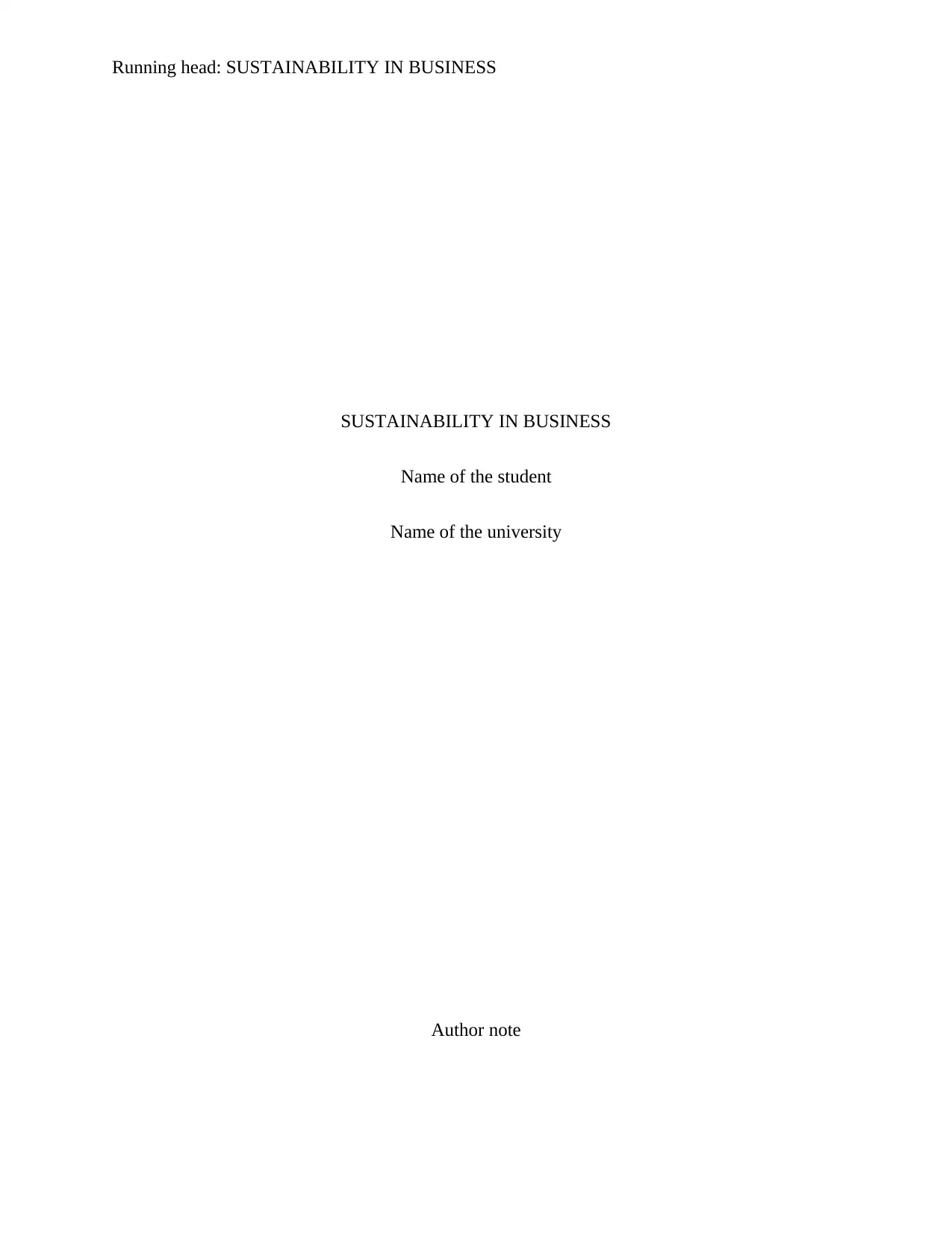
Running head: SUSTAINABILITY IN BUSINESS
SUSTAINABILITY IN BUSINESS
Name of the student
Name of the university
Author note
SUSTAINABILITY IN BUSINESS
Name of the student
Name of the university
Author note
Secure Best Marks with AI Grader
Need help grading? Try our AI Grader for instant feedback on your assignments.
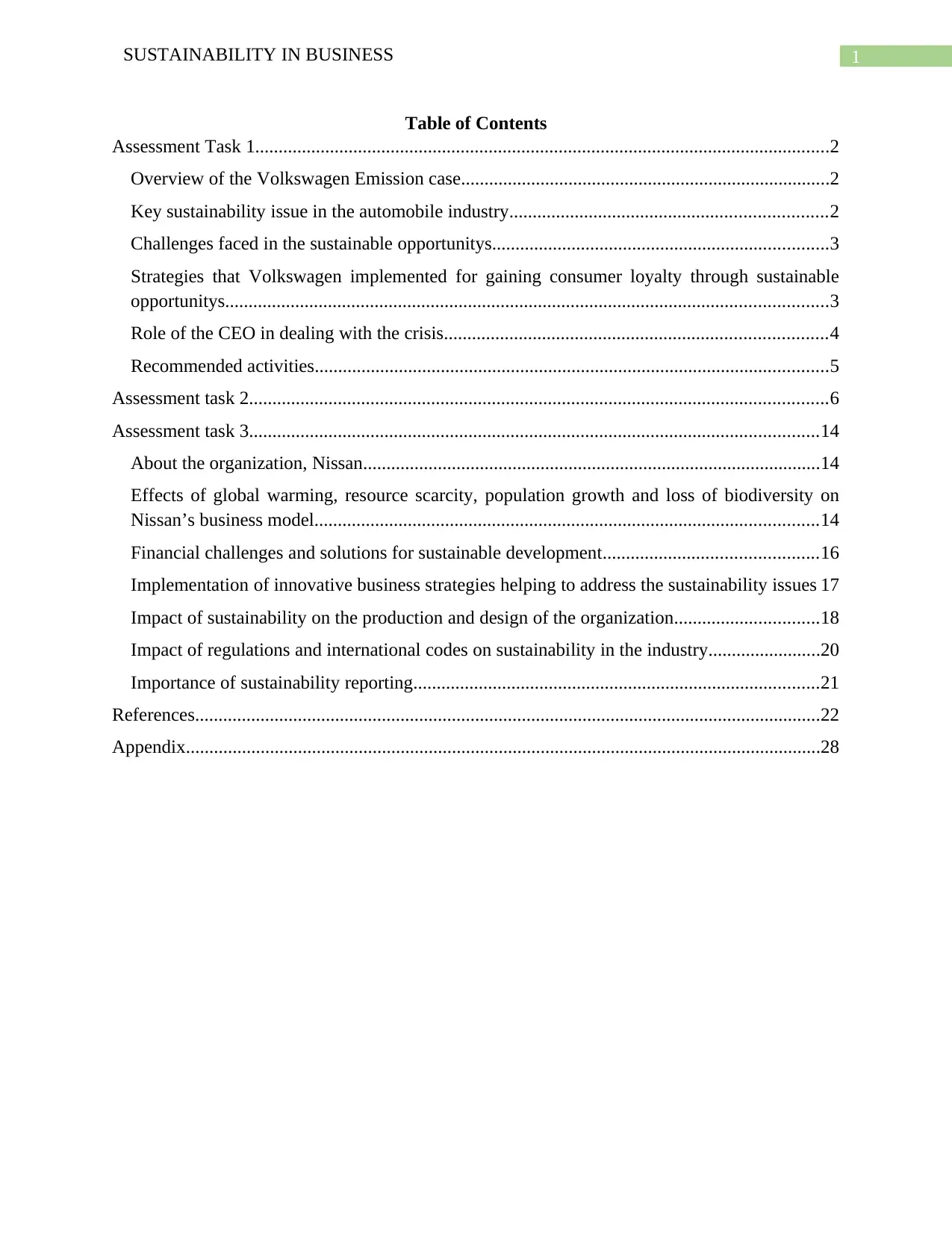
1SUSTAINABILITY IN BUSINESS
Table of Contents
Assessment Task 1...........................................................................................................................2
Overview of the Volkswagen Emission case...............................................................................2
Key sustainability issue in the automobile industry....................................................................2
Challenges faced in the sustainable opportunitys........................................................................3
Strategies that Volkswagen implemented for gaining consumer loyalty through sustainable
opportunitys.................................................................................................................................3
Role of the CEO in dealing with the crisis..................................................................................4
Recommended activities..............................................................................................................5
Assessment task 2............................................................................................................................6
Assessment task 3..........................................................................................................................14
About the organization, Nissan..................................................................................................14
Effects of global warming, resource scarcity, population growth and loss of biodiversity on
Nissan’s business model............................................................................................................14
Financial challenges and solutions for sustainable development..............................................16
Implementation of innovative business strategies helping to address the sustainability issues 17
Impact of sustainability on the production and design of the organization...............................18
Impact of regulations and international codes on sustainability in the industry........................20
Importance of sustainability reporting.......................................................................................21
References......................................................................................................................................22
Appendix........................................................................................................................................28
Table of Contents
Assessment Task 1...........................................................................................................................2
Overview of the Volkswagen Emission case...............................................................................2
Key sustainability issue in the automobile industry....................................................................2
Challenges faced in the sustainable opportunitys........................................................................3
Strategies that Volkswagen implemented for gaining consumer loyalty through sustainable
opportunitys.................................................................................................................................3
Role of the CEO in dealing with the crisis..................................................................................4
Recommended activities..............................................................................................................5
Assessment task 2............................................................................................................................6
Assessment task 3..........................................................................................................................14
About the organization, Nissan..................................................................................................14
Effects of global warming, resource scarcity, population growth and loss of biodiversity on
Nissan’s business model............................................................................................................14
Financial challenges and solutions for sustainable development..............................................16
Implementation of innovative business strategies helping to address the sustainability issues 17
Impact of sustainability on the production and design of the organization...............................18
Impact of regulations and international codes on sustainability in the industry........................20
Importance of sustainability reporting.......................................................................................21
References......................................................................................................................................22
Appendix........................................................................................................................................28
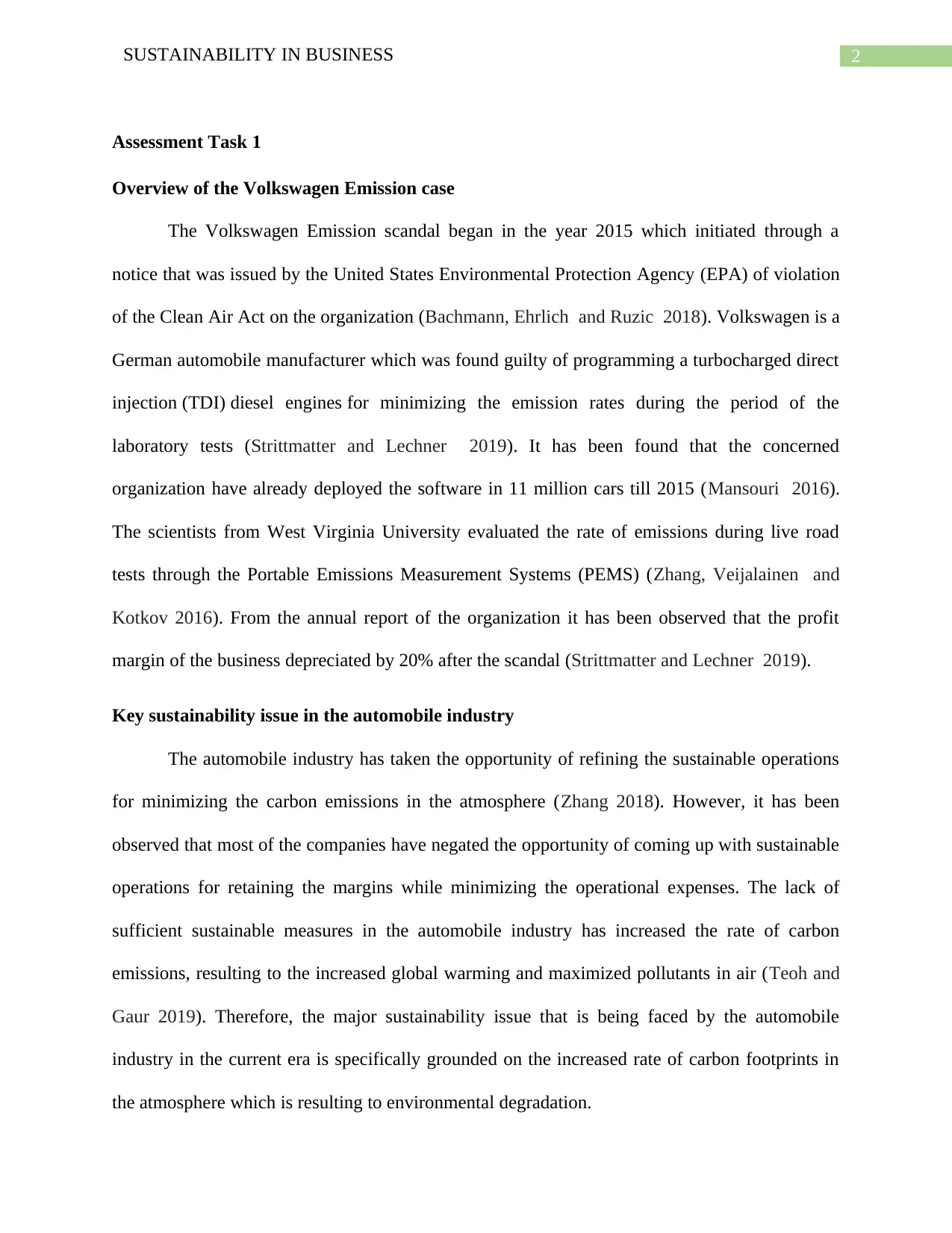
2SUSTAINABILITY IN BUSINESS
Assessment Task 1
Overview of the Volkswagen Emission case
The Volkswagen Emission scandal began in the year 2015 which initiated through a
notice that was issued by the United States Environmental Protection Agency (EPA) of violation
of the Clean Air Act on the organization (Bachmann, Ehrlich and Ruzic 2018). Volkswagen is a
German automobile manufacturer which was found guilty of programming a turbocharged direct
injection (TDI) diesel engines for minimizing the emission rates during the period of the
laboratory tests (Strittmatter and Lechner 2019). It has been found that the concerned
organization have already deployed the software in 11 million cars till 2015 (Mansouri 2016).
The scientists from West Virginia University evaluated the rate of emissions during live road
tests through the Portable Emissions Measurement Systems (PEMS) (Zhang, Veijalainen and
Kotkov 2016). From the annual report of the organization it has been observed that the profit
margin of the business depreciated by 20% after the scandal (Strittmatter and Lechner 2019).
Key sustainability issue in the automobile industry
The automobile industry has taken the opportunity of refining the sustainable operations
for minimizing the carbon emissions in the atmosphere (Zhang 2018). However, it has been
observed that most of the companies have negated the opportunity of coming up with sustainable
operations for retaining the margins while minimizing the operational expenses. The lack of
sufficient sustainable measures in the automobile industry has increased the rate of carbon
emissions, resulting to the increased global warming and maximized pollutants in air (Teoh and
Gaur 2019). Therefore, the major sustainability issue that is being faced by the automobile
industry in the current era is specifically grounded on the increased rate of carbon footprints in
the atmosphere which is resulting to environmental degradation.
Assessment Task 1
Overview of the Volkswagen Emission case
The Volkswagen Emission scandal began in the year 2015 which initiated through a
notice that was issued by the United States Environmental Protection Agency (EPA) of violation
of the Clean Air Act on the organization (Bachmann, Ehrlich and Ruzic 2018). Volkswagen is a
German automobile manufacturer which was found guilty of programming a turbocharged direct
injection (TDI) diesel engines for minimizing the emission rates during the period of the
laboratory tests (Strittmatter and Lechner 2019). It has been found that the concerned
organization have already deployed the software in 11 million cars till 2015 (Mansouri 2016).
The scientists from West Virginia University evaluated the rate of emissions during live road
tests through the Portable Emissions Measurement Systems (PEMS) (Zhang, Veijalainen and
Kotkov 2016). From the annual report of the organization it has been observed that the profit
margin of the business depreciated by 20% after the scandal (Strittmatter and Lechner 2019).
Key sustainability issue in the automobile industry
The automobile industry has taken the opportunity of refining the sustainable operations
for minimizing the carbon emissions in the atmosphere (Zhang 2018). However, it has been
observed that most of the companies have negated the opportunity of coming up with sustainable
operations for retaining the margins while minimizing the operational expenses. The lack of
sufficient sustainable measures in the automobile industry has increased the rate of carbon
emissions, resulting to the increased global warming and maximized pollutants in air (Teoh and
Gaur 2019). Therefore, the major sustainability issue that is being faced by the automobile
industry in the current era is specifically grounded on the increased rate of carbon footprints in
the atmosphere which is resulting to environmental degradation.
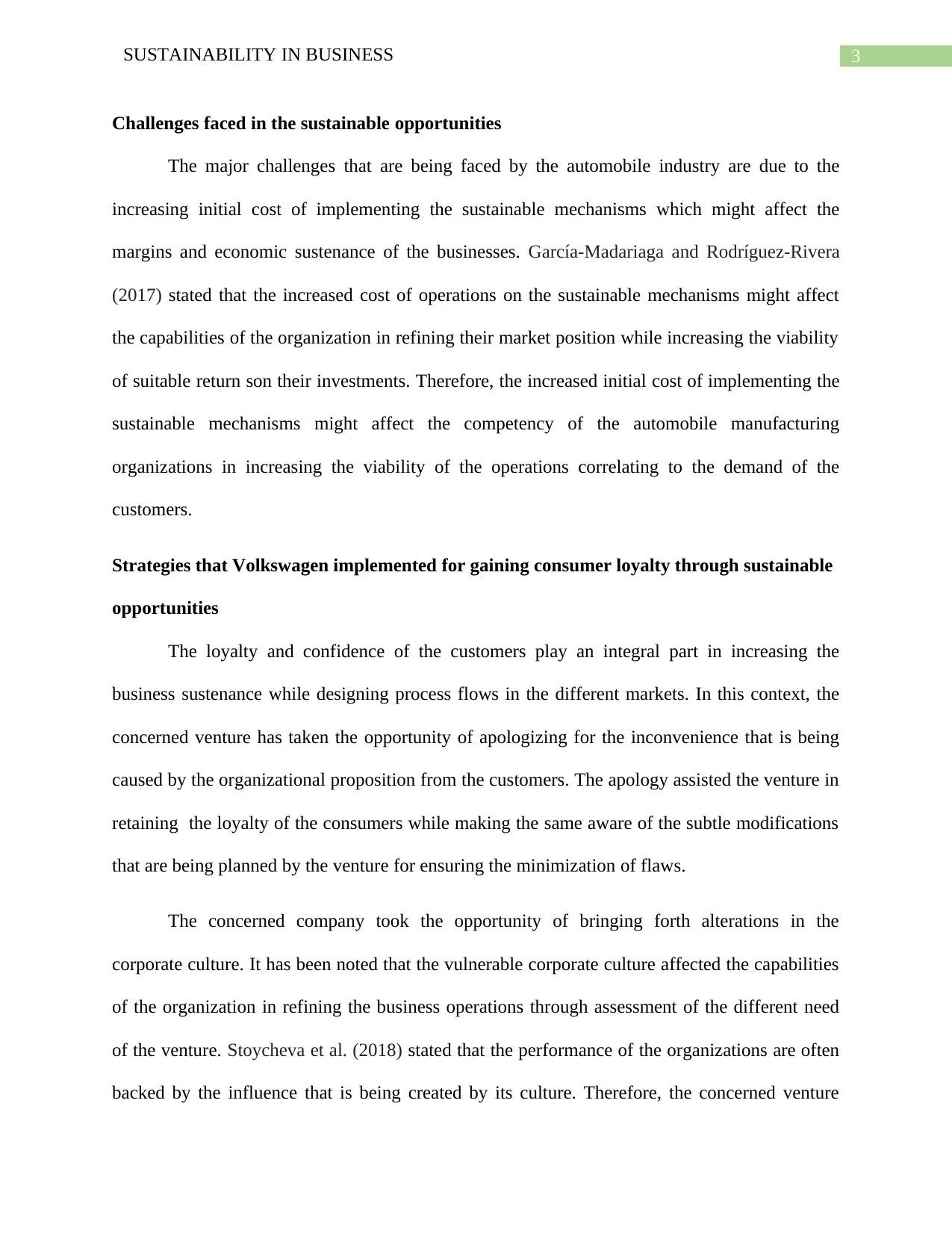
3SUSTAINABILITY IN BUSINESS
Challenges faced in the sustainable opportunities
The major challenges that are being faced by the automobile industry are due to the
increasing initial cost of implementing the sustainable mechanisms which might affect the
margins and economic sustenance of the businesses. García-Madariaga and Rodríguez-Rivera
(2017) stated that the increased cost of operations on the sustainable mechanisms might affect
the capabilities of the organization in refining their market position while increasing the viability
of suitable return son their investments. Therefore, the increased initial cost of implementing the
sustainable mechanisms might affect the competency of the automobile manufacturing
organizations in increasing the viability of the operations correlating to the demand of the
customers.
Strategies that Volkswagen implemented for gaining consumer loyalty through sustainable
opportunities
The loyalty and confidence of the customers play an integral part in increasing the
business sustenance while designing process flows in the different markets. In this context, the
concerned venture has taken the opportunity of apologizing for the inconvenience that is being
caused by the organizational proposition from the customers. The apology assisted the venture in
retaining the loyalty of the consumers while making the same aware of the subtle modifications
that are being planned by the venture for ensuring the minimization of flaws.
The concerned company took the opportunity of bringing forth alterations in the
corporate culture. It has been noted that the vulnerable corporate culture affected the capabilities
of the organization in refining the business operations through assessment of the different need
of the venture. Stoycheva et al. (2018) stated that the performance of the organizations are often
backed by the influence that is being created by its culture. Therefore, the concerned venture
Challenges faced in the sustainable opportunities
The major challenges that are being faced by the automobile industry are due to the
increasing initial cost of implementing the sustainable mechanisms which might affect the
margins and economic sustenance of the businesses. García-Madariaga and Rodríguez-Rivera
(2017) stated that the increased cost of operations on the sustainable mechanisms might affect
the capabilities of the organization in refining their market position while increasing the viability
of suitable return son their investments. Therefore, the increased initial cost of implementing the
sustainable mechanisms might affect the competency of the automobile manufacturing
organizations in increasing the viability of the operations correlating to the demand of the
customers.
Strategies that Volkswagen implemented for gaining consumer loyalty through sustainable
opportunities
The loyalty and confidence of the customers play an integral part in increasing the
business sustenance while designing process flows in the different markets. In this context, the
concerned venture has taken the opportunity of apologizing for the inconvenience that is being
caused by the organizational proposition from the customers. The apology assisted the venture in
retaining the loyalty of the consumers while making the same aware of the subtle modifications
that are being planned by the venture for ensuring the minimization of flaws.
The concerned company took the opportunity of bringing forth alterations in the
corporate culture. It has been noted that the vulnerable corporate culture affected the capabilities
of the organization in refining the business operations through assessment of the different need
of the venture. Stoycheva et al. (2018) stated that the performance of the organizations are often
backed by the influence that is being created by its culture. Therefore, the concerned venture
Secure Best Marks with AI Grader
Need help grading? Try our AI Grader for instant feedback on your assignments.
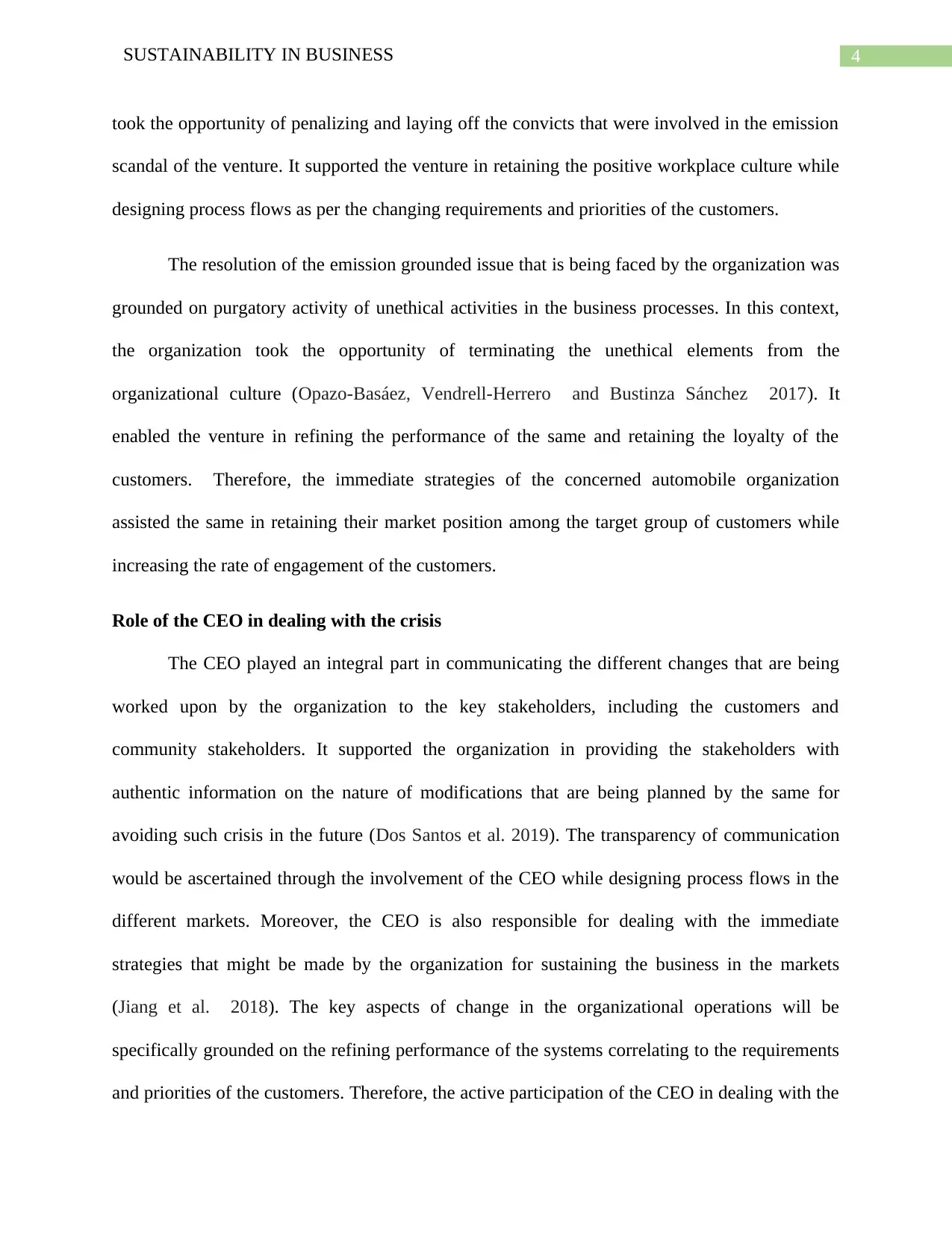
4SUSTAINABILITY IN BUSINESS
took the opportunity of penalizing and laying off the convicts that were involved in the emission
scandal of the venture. It supported the venture in retaining the positive workplace culture while
designing process flows as per the changing requirements and priorities of the customers.
The resolution of the emission grounded issue that is being faced by the organization was
grounded on purgatory activity of unethical activities in the business processes. In this context,
the organization took the opportunity of terminating the unethical elements from the
organizational culture (Opazo-Basáez, Vendrell-Herrero and Bustinza Sánchez 2017). It
enabled the venture in refining the performance of the same and retaining the loyalty of the
customers. Therefore, the immediate strategies of the concerned automobile organization
assisted the same in retaining their market position among the target group of customers while
increasing the rate of engagement of the customers.
Role of the CEO in dealing with the crisis
The CEO played an integral part in communicating the different changes that are being
worked upon by the organization to the key stakeholders, including the customers and
community stakeholders. It supported the organization in providing the stakeholders with
authentic information on the nature of modifications that are being planned by the same for
avoiding such crisis in the future (Dos Santos et al. 2019). The transparency of communication
would be ascertained through the involvement of the CEO while designing process flows in the
different markets. Moreover, the CEO is also responsible for dealing with the immediate
strategies that might be made by the organization for sustaining the business in the markets
(Jiang et al. 2018). The key aspects of change in the organizational operations will be
specifically grounded on the refining performance of the systems correlating to the requirements
and priorities of the customers. Therefore, the active participation of the CEO in dealing with the
took the opportunity of penalizing and laying off the convicts that were involved in the emission
scandal of the venture. It supported the venture in retaining the positive workplace culture while
designing process flows as per the changing requirements and priorities of the customers.
The resolution of the emission grounded issue that is being faced by the organization was
grounded on purgatory activity of unethical activities in the business processes. In this context,
the organization took the opportunity of terminating the unethical elements from the
organizational culture (Opazo-Basáez, Vendrell-Herrero and Bustinza Sánchez 2017). It
enabled the venture in refining the performance of the same and retaining the loyalty of the
customers. Therefore, the immediate strategies of the concerned automobile organization
assisted the same in retaining their market position among the target group of customers while
increasing the rate of engagement of the customers.
Role of the CEO in dealing with the crisis
The CEO played an integral part in communicating the different changes that are being
worked upon by the organization to the key stakeholders, including the customers and
community stakeholders. It supported the organization in providing the stakeholders with
authentic information on the nature of modifications that are being planned by the same for
avoiding such crisis in the future (Dos Santos et al. 2019). The transparency of communication
would be ascertained through the involvement of the CEO while designing process flows in the
different markets. Moreover, the CEO is also responsible for dealing with the immediate
strategies that might be made by the organization for sustaining the business in the markets
(Jiang et al. 2018). The key aspects of change in the organizational operations will be
specifically grounded on the refining performance of the systems correlating to the requirements
and priorities of the customers. Therefore, the active participation of the CEO in dealing with the
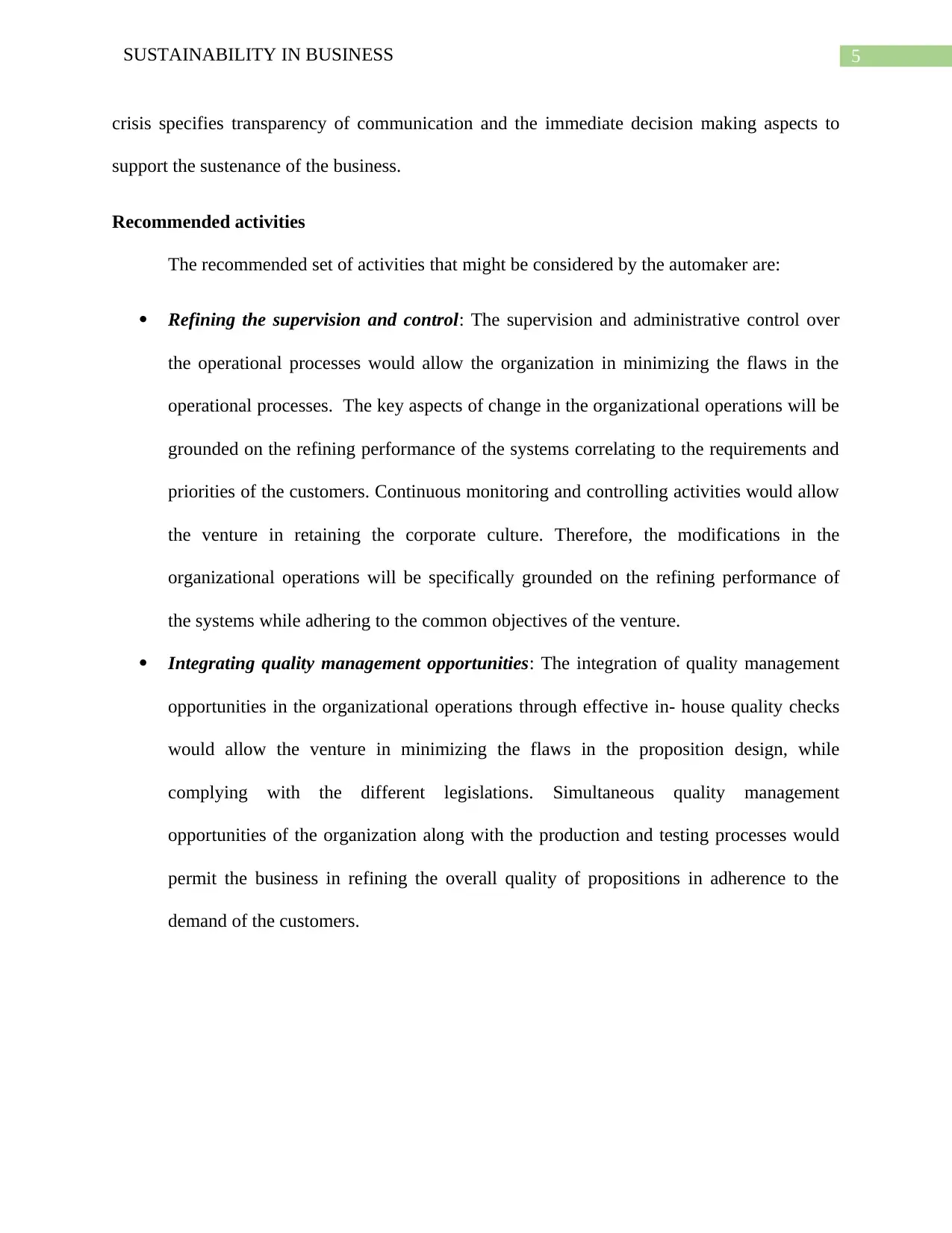
5SUSTAINABILITY IN BUSINESS
crisis specifies transparency of communication and the immediate decision making aspects to
support the sustenance of the business.
Recommended activities
The recommended set of activities that might be considered by the automaker are:
Refining the supervision and control: The supervision and administrative control over
the operational processes would allow the organization in minimizing the flaws in the
operational processes. The key aspects of change in the organizational operations will be
grounded on the refining performance of the systems correlating to the requirements and
priorities of the customers. Continuous monitoring and controlling activities would allow
the venture in retaining the corporate culture. Therefore, the modifications in the
organizational operations will be specifically grounded on the refining performance of
the systems while adhering to the common objectives of the venture.
Integrating quality management opportunities: The integration of quality management
opportunities in the organizational operations through effective in- house quality checks
would allow the venture in minimizing the flaws in the proposition design, while
complying with the different legislations. Simultaneous quality management
opportunities of the organization along with the production and testing processes would
permit the business in refining the overall quality of propositions in adherence to the
demand of the customers.
crisis specifies transparency of communication and the immediate decision making aspects to
support the sustenance of the business.
Recommended activities
The recommended set of activities that might be considered by the automaker are:
Refining the supervision and control: The supervision and administrative control over
the operational processes would allow the organization in minimizing the flaws in the
operational processes. The key aspects of change in the organizational operations will be
grounded on the refining performance of the systems correlating to the requirements and
priorities of the customers. Continuous monitoring and controlling activities would allow
the venture in retaining the corporate culture. Therefore, the modifications in the
organizational operations will be specifically grounded on the refining performance of
the systems while adhering to the common objectives of the venture.
Integrating quality management opportunities: The integration of quality management
opportunities in the organizational operations through effective in- house quality checks
would allow the venture in minimizing the flaws in the proposition design, while
complying with the different legislations. Simultaneous quality management
opportunities of the organization along with the production and testing processes would
permit the business in refining the overall quality of propositions in adherence to the
demand of the customers.
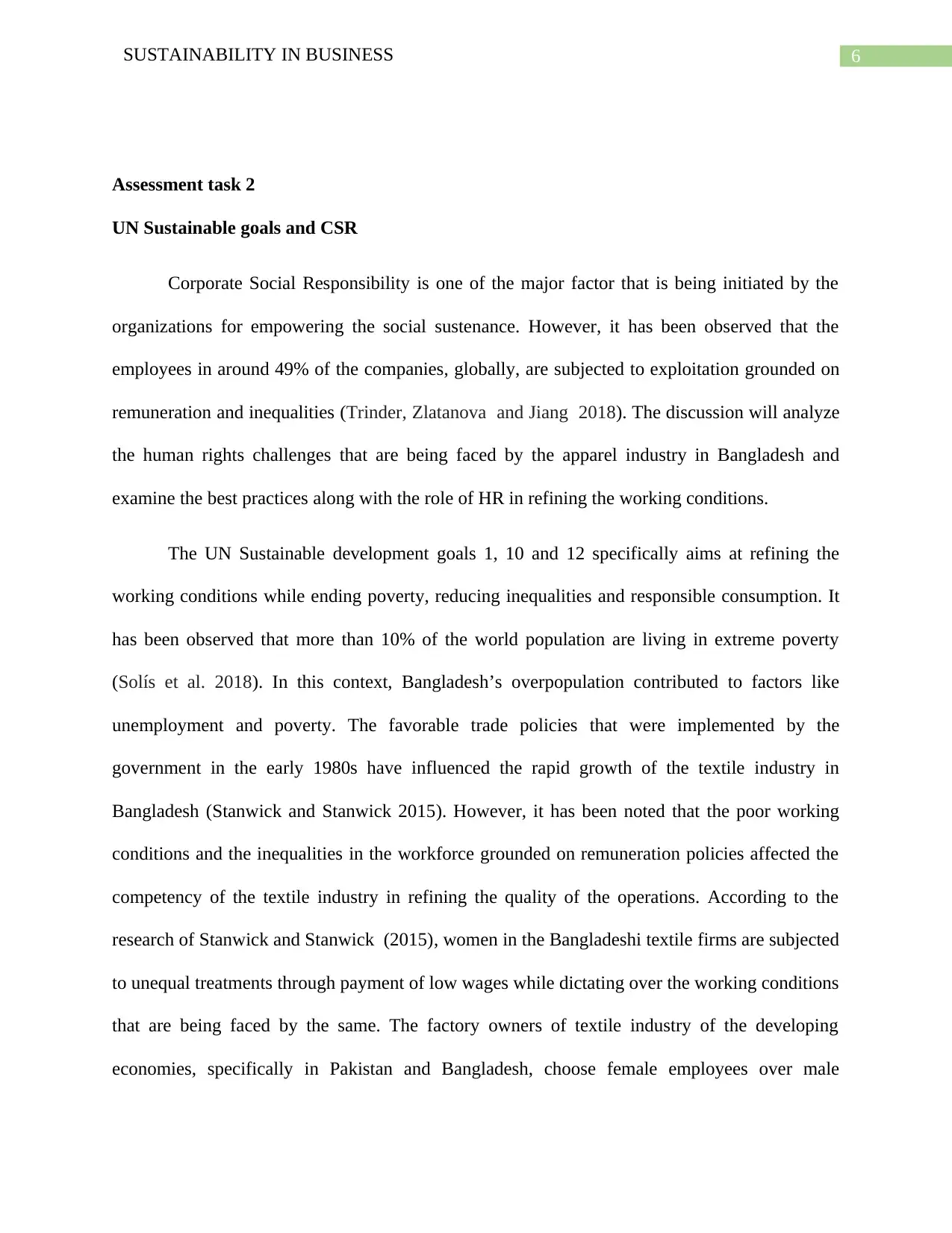
6SUSTAINABILITY IN BUSINESS
Assessment task 2
UN Sustainable goals and CSR
Corporate Social Responsibility is one of the major factor that is being initiated by the
organizations for empowering the social sustenance. However, it has been observed that the
employees in around 49% of the companies, globally, are subjected to exploitation grounded on
remuneration and inequalities (Trinder, Zlatanova and Jiang 2018). The discussion will analyze
the human rights challenges that are being faced by the apparel industry in Bangladesh and
examine the best practices along with the role of HR in refining the working conditions.
The UN Sustainable development goals 1, 10 and 12 specifically aims at refining the
working conditions while ending poverty, reducing inequalities and responsible consumption. It
has been observed that more than 10% of the world population are living in extreme poverty
(Solís et al. 2018). In this context, Bangladesh’s overpopulation contributed to factors like
unemployment and poverty. The favorable trade policies that were implemented by the
government in the early 1980s have influenced the rapid growth of the textile industry in
Bangladesh (Stanwick and Stanwick 2015). However, it has been noted that the poor working
conditions and the inequalities in the workforce grounded on remuneration policies affected the
competency of the textile industry in refining the quality of the operations. According to the
research of Stanwick and Stanwick (2015), women in the Bangladeshi textile firms are subjected
to unequal treatments through payment of low wages while dictating over the working conditions
that are being faced by the same. The factory owners of textile industry of the developing
economies, specifically in Pakistan and Bangladesh, choose female employees over male
Assessment task 2
UN Sustainable goals and CSR
Corporate Social Responsibility is one of the major factor that is being initiated by the
organizations for empowering the social sustenance. However, it has been observed that the
employees in around 49% of the companies, globally, are subjected to exploitation grounded on
remuneration and inequalities (Trinder, Zlatanova and Jiang 2018). The discussion will analyze
the human rights challenges that are being faced by the apparel industry in Bangladesh and
examine the best practices along with the role of HR in refining the working conditions.
The UN Sustainable development goals 1, 10 and 12 specifically aims at refining the
working conditions while ending poverty, reducing inequalities and responsible consumption. It
has been observed that more than 10% of the world population are living in extreme poverty
(Solís et al. 2018). In this context, Bangladesh’s overpopulation contributed to factors like
unemployment and poverty. The favorable trade policies that were implemented by the
government in the early 1980s have influenced the rapid growth of the textile industry in
Bangladesh (Stanwick and Stanwick 2015). However, it has been noted that the poor working
conditions and the inequalities in the workforce grounded on remuneration policies affected the
competency of the textile industry in refining the quality of the operations. According to the
research of Stanwick and Stanwick (2015), women in the Bangladeshi textile firms are subjected
to unequal treatments through payment of low wages while dictating over the working conditions
that are being faced by the same. The factory owners of textile industry of the developing
economies, specifically in Pakistan and Bangladesh, choose female employees over male
Paraphrase This Document
Need a fresh take? Get an instant paraphrase of this document with our AI Paraphraser
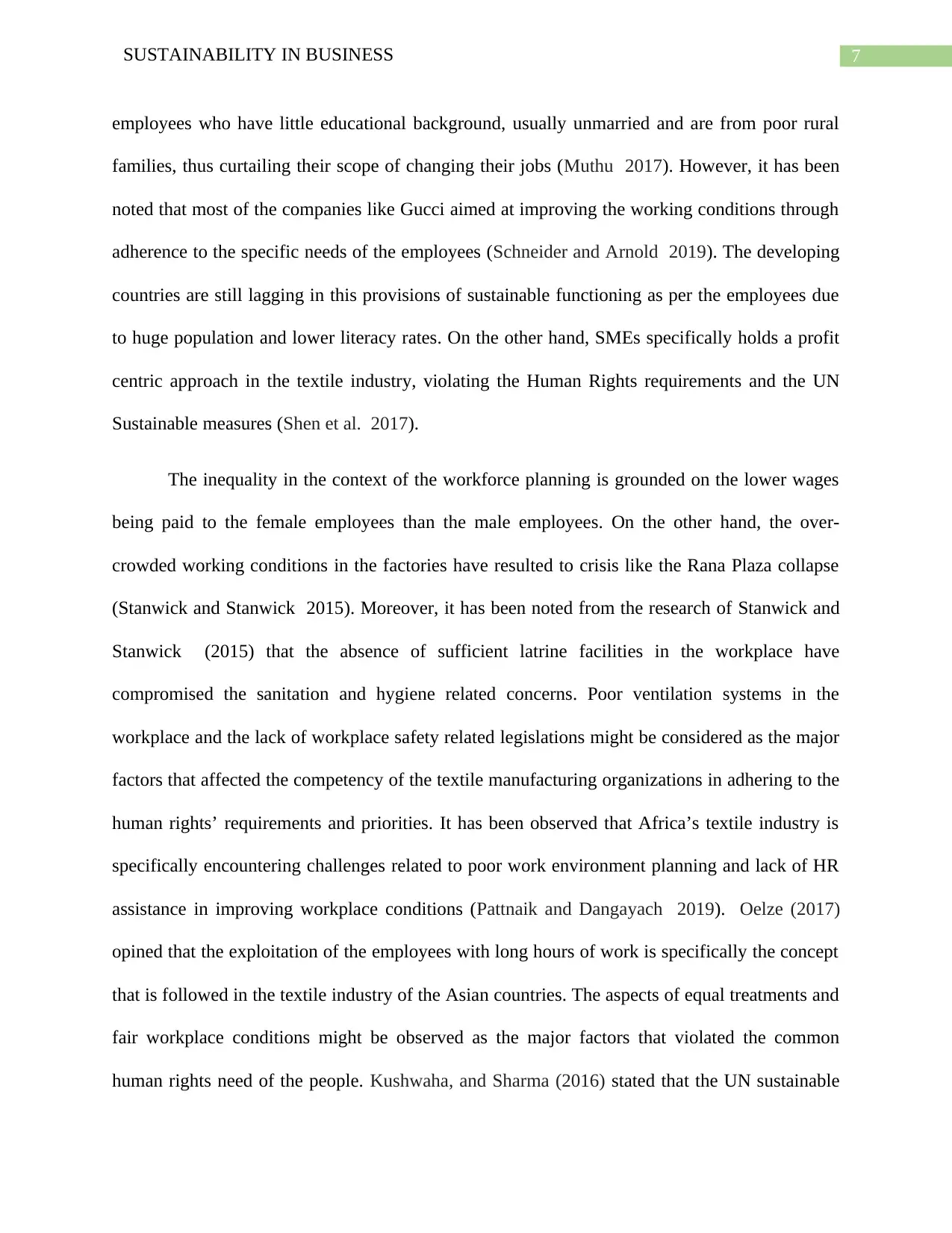
7SUSTAINABILITY IN BUSINESS
employees who have little educational background, usually unmarried and are from poor rural
families, thus curtailing their scope of changing their jobs (Muthu 2017). However, it has been
noted that most of the companies like Gucci aimed at improving the working conditions through
adherence to the specific needs of the employees (Schneider and Arnold 2019). The developing
countries are still lagging in this provisions of sustainable functioning as per the employees due
to huge population and lower literacy rates. On the other hand, SMEs specifically holds a profit
centric approach in the textile industry, violating the Human Rights requirements and the UN
Sustainable measures (Shen et al. 2017).
The inequality in the context of the workforce planning is grounded on the lower wages
being paid to the female employees than the male employees. On the other hand, the over-
crowded working conditions in the factories have resulted to crisis like the Rana Plaza collapse
(Stanwick and Stanwick 2015). Moreover, it has been noted from the research of Stanwick and
Stanwick (2015) that the absence of sufficient latrine facilities in the workplace have
compromised the sanitation and hygiene related concerns. Poor ventilation systems in the
workplace and the lack of workplace safety related legislations might be considered as the major
factors that affected the competency of the textile manufacturing organizations in adhering to the
human rights’ requirements and priorities. It has been observed that Africa’s textile industry is
specifically encountering challenges related to poor work environment planning and lack of HR
assistance in improving workplace conditions (Pattnaik and Dangayach 2019). Oelze (2017)
opined that the exploitation of the employees with long hours of work is specifically the concept
that is followed in the textile industry of the Asian countries. The aspects of equal treatments and
fair workplace conditions might be observed as the major factors that violated the common
human rights need of the people. Kushwaha, and Sharma (2016) stated that the UN sustainable
employees who have little educational background, usually unmarried and are from poor rural
families, thus curtailing their scope of changing their jobs (Muthu 2017). However, it has been
noted that most of the companies like Gucci aimed at improving the working conditions through
adherence to the specific needs of the employees (Schneider and Arnold 2019). The developing
countries are still lagging in this provisions of sustainable functioning as per the employees due
to huge population and lower literacy rates. On the other hand, SMEs specifically holds a profit
centric approach in the textile industry, violating the Human Rights requirements and the UN
Sustainable measures (Shen et al. 2017).
The inequality in the context of the workforce planning is grounded on the lower wages
being paid to the female employees than the male employees. On the other hand, the over-
crowded working conditions in the factories have resulted to crisis like the Rana Plaza collapse
(Stanwick and Stanwick 2015). Moreover, it has been noted from the research of Stanwick and
Stanwick (2015) that the absence of sufficient latrine facilities in the workplace have
compromised the sanitation and hygiene related concerns. Poor ventilation systems in the
workplace and the lack of workplace safety related legislations might be considered as the major
factors that affected the competency of the textile manufacturing organizations in adhering to the
human rights’ requirements and priorities. It has been observed that Africa’s textile industry is
specifically encountering challenges related to poor work environment planning and lack of HR
assistance in improving workplace conditions (Pattnaik and Dangayach 2019). Oelze (2017)
opined that the exploitation of the employees with long hours of work is specifically the concept
that is followed in the textile industry of the Asian countries. The aspects of equal treatments and
fair workplace conditions might be observed as the major factors that violated the common
human rights need of the people. Kushwaha, and Sharma (2016) stated that the UN sustainable
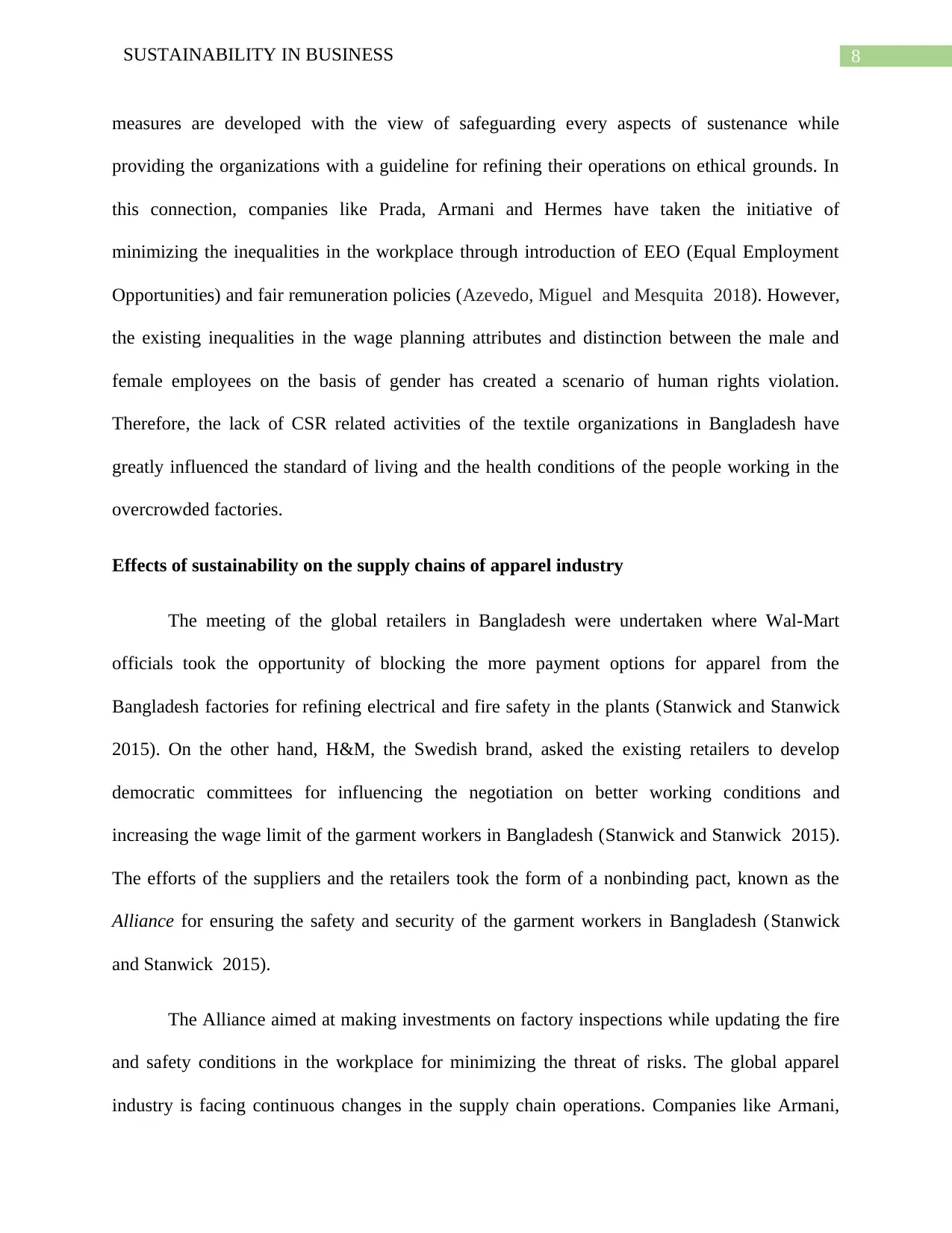
8SUSTAINABILITY IN BUSINESS
measures are developed with the view of safeguarding every aspects of sustenance while
providing the organizations with a guideline for refining their operations on ethical grounds. In
this connection, companies like Prada, Armani and Hermes have taken the initiative of
minimizing the inequalities in the workplace through introduction of EEO (Equal Employment
Opportunities) and fair remuneration policies (Azevedo, Miguel and Mesquita 2018). However,
the existing inequalities in the wage planning attributes and distinction between the male and
female employees on the basis of gender has created a scenario of human rights violation.
Therefore, the lack of CSR related activities of the textile organizations in Bangladesh have
greatly influenced the standard of living and the health conditions of the people working in the
overcrowded factories.
Effects of sustainability on the supply chains of apparel industry
The meeting of the global retailers in Bangladesh were undertaken where Wal-Mart
officials took the opportunity of blocking the more payment options for apparel from the
Bangladesh factories for refining electrical and fire safety in the plants (Stanwick and Stanwick
2015). On the other hand, H&M, the Swedish brand, asked the existing retailers to develop
democratic committees for influencing the negotiation on better working conditions and
increasing the wage limit of the garment workers in Bangladesh (Stanwick and Stanwick 2015).
The efforts of the suppliers and the retailers took the form of a nonbinding pact, known as the
Alliance for ensuring the safety and security of the garment workers in Bangladesh (Stanwick
and Stanwick 2015).
The Alliance aimed at making investments on factory inspections while updating the fire
and safety conditions in the workplace for minimizing the threat of risks. The global apparel
industry is facing continuous changes in the supply chain operations. Companies like Armani,
measures are developed with the view of safeguarding every aspects of sustenance while
providing the organizations with a guideline for refining their operations on ethical grounds. In
this connection, companies like Prada, Armani and Hermes have taken the initiative of
minimizing the inequalities in the workplace through introduction of EEO (Equal Employment
Opportunities) and fair remuneration policies (Azevedo, Miguel and Mesquita 2018). However,
the existing inequalities in the wage planning attributes and distinction between the male and
female employees on the basis of gender has created a scenario of human rights violation.
Therefore, the lack of CSR related activities of the textile organizations in Bangladesh have
greatly influenced the standard of living and the health conditions of the people working in the
overcrowded factories.
Effects of sustainability on the supply chains of apparel industry
The meeting of the global retailers in Bangladesh were undertaken where Wal-Mart
officials took the opportunity of blocking the more payment options for apparel from the
Bangladesh factories for refining electrical and fire safety in the plants (Stanwick and Stanwick
2015). On the other hand, H&M, the Swedish brand, asked the existing retailers to develop
democratic committees for influencing the negotiation on better working conditions and
increasing the wage limit of the garment workers in Bangladesh (Stanwick and Stanwick 2015).
The efforts of the suppliers and the retailers took the form of a nonbinding pact, known as the
Alliance for ensuring the safety and security of the garment workers in Bangladesh (Stanwick
and Stanwick 2015).
The Alliance aimed at making investments on factory inspections while updating the fire
and safety conditions in the workplace for minimizing the threat of risks. The global apparel
industry is facing continuous changes in the supply chain operations. Companies like Armani,
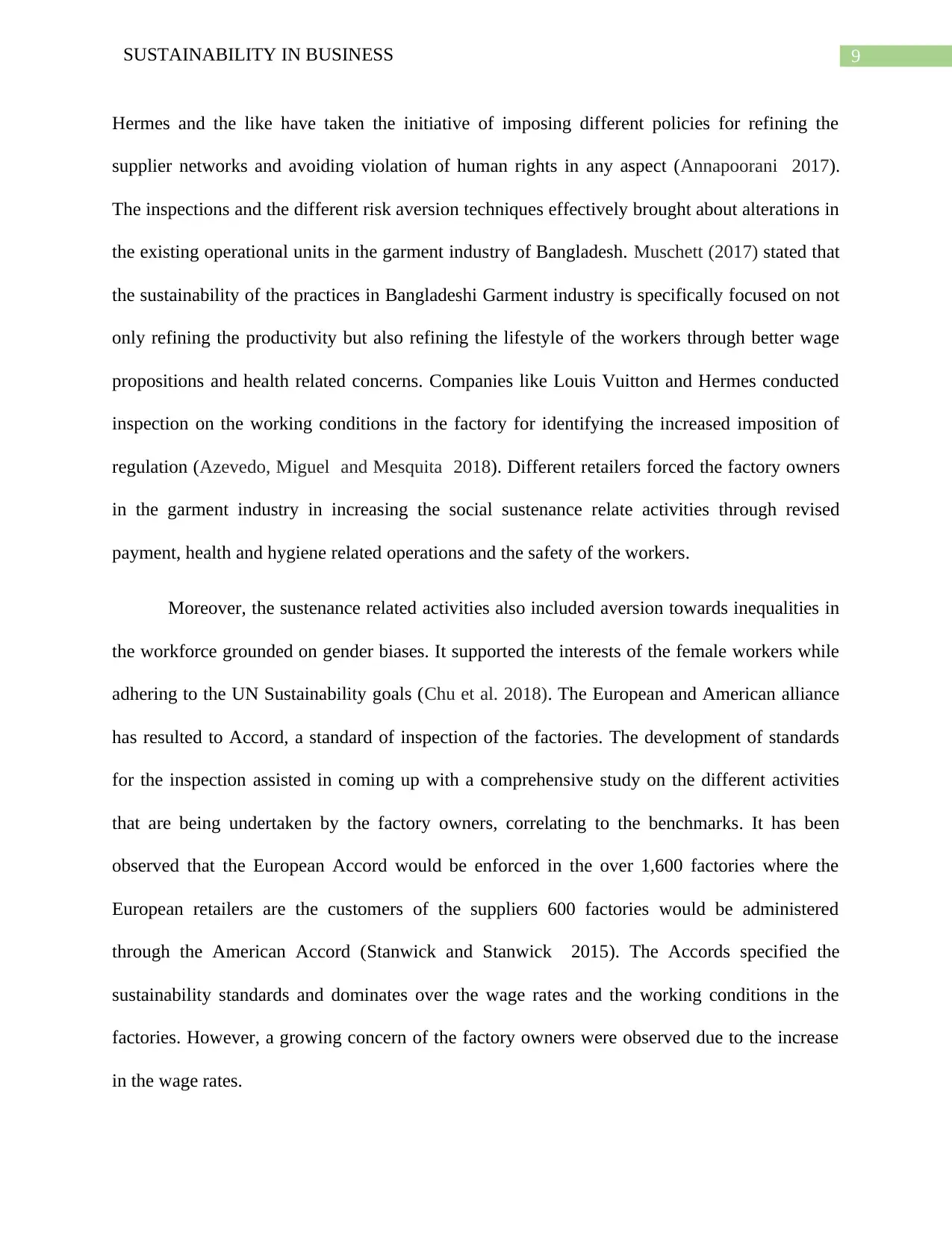
9SUSTAINABILITY IN BUSINESS
Hermes and the like have taken the initiative of imposing different policies for refining the
supplier networks and avoiding violation of human rights in any aspect (Annapoorani 2017).
The inspections and the different risk aversion techniques effectively brought about alterations in
the existing operational units in the garment industry of Bangladesh. Muschett (2017) stated that
the sustainability of the practices in Bangladeshi Garment industry is specifically focused on not
only refining the productivity but also refining the lifestyle of the workers through better wage
propositions and health related concerns. Companies like Louis Vuitton and Hermes conducted
inspection on the working conditions in the factory for identifying the increased imposition of
regulation (Azevedo, Miguel and Mesquita 2018). Different retailers forced the factory owners
in the garment industry in increasing the social sustenance relate activities through revised
payment, health and hygiene related operations and the safety of the workers.
Moreover, the sustenance related activities also included aversion towards inequalities in
the workforce grounded on gender biases. It supported the interests of the female workers while
adhering to the UN Sustainability goals (Chu et al. 2018). The European and American alliance
has resulted to Accord, a standard of inspection of the factories. The development of standards
for the inspection assisted in coming up with a comprehensive study on the different activities
that are being undertaken by the factory owners, correlating to the benchmarks. It has been
observed that the European Accord would be enforced in the over 1,600 factories where the
European retailers are the customers of the suppliers 600 factories would be administered
through the American Accord (Stanwick and Stanwick 2015). The Accords specified the
sustainability standards and dominates over the wage rates and the working conditions in the
factories. However, a growing concern of the factory owners were observed due to the increase
in the wage rates.
Hermes and the like have taken the initiative of imposing different policies for refining the
supplier networks and avoiding violation of human rights in any aspect (Annapoorani 2017).
The inspections and the different risk aversion techniques effectively brought about alterations in
the existing operational units in the garment industry of Bangladesh. Muschett (2017) stated that
the sustainability of the practices in Bangladeshi Garment industry is specifically focused on not
only refining the productivity but also refining the lifestyle of the workers through better wage
propositions and health related concerns. Companies like Louis Vuitton and Hermes conducted
inspection on the working conditions in the factory for identifying the increased imposition of
regulation (Azevedo, Miguel and Mesquita 2018). Different retailers forced the factory owners
in the garment industry in increasing the social sustenance relate activities through revised
payment, health and hygiene related operations and the safety of the workers.
Moreover, the sustenance related activities also included aversion towards inequalities in
the workforce grounded on gender biases. It supported the interests of the female workers while
adhering to the UN Sustainability goals (Chu et al. 2018). The European and American alliance
has resulted to Accord, a standard of inspection of the factories. The development of standards
for the inspection assisted in coming up with a comprehensive study on the different activities
that are being undertaken by the factory owners, correlating to the benchmarks. It has been
observed that the European Accord would be enforced in the over 1,600 factories where the
European retailers are the customers of the suppliers 600 factories would be administered
through the American Accord (Stanwick and Stanwick 2015). The Accords specified the
sustainability standards and dominates over the wage rates and the working conditions in the
factories. However, a growing concern of the factory owners were observed due to the increase
in the wage rates.
Secure Best Marks with AI Grader
Need help grading? Try our AI Grader for instant feedback on your assignments.
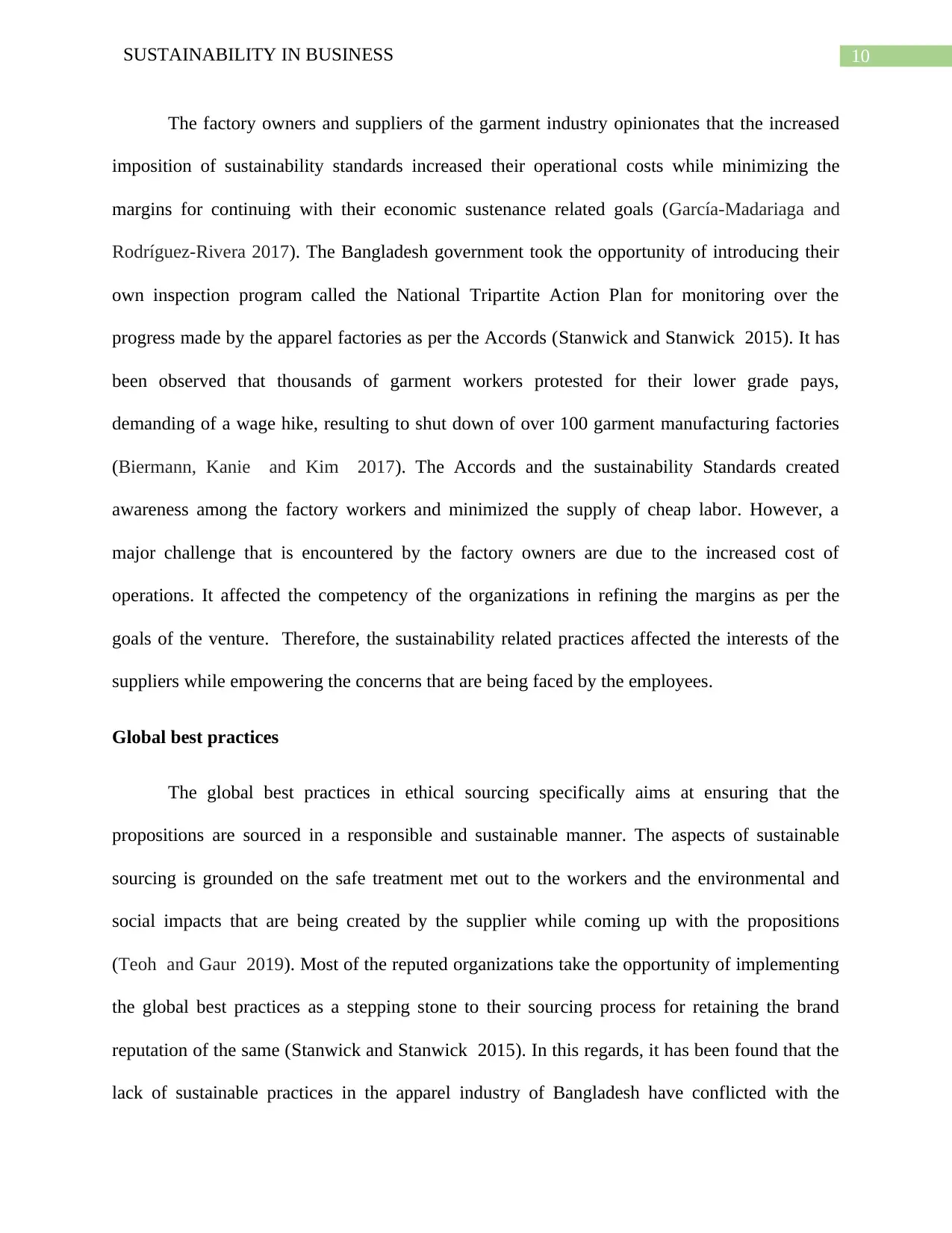
10SUSTAINABILITY IN BUSINESS
The factory owners and suppliers of the garment industry opinionates that the increased
imposition of sustainability standards increased their operational costs while minimizing the
margins for continuing with their economic sustenance related goals (García-Madariaga and
Rodríguez-Rivera 2017). The Bangladesh government took the opportunity of introducing their
own inspection program called the National Tripartite Action Plan for monitoring over the
progress made by the apparel factories as per the Accords (Stanwick and Stanwick 2015). It has
been observed that thousands of garment workers protested for their lower grade pays,
demanding of a wage hike, resulting to shut down of over 100 garment manufacturing factories
(Biermann, Kanie and Kim 2017). The Accords and the sustainability Standards created
awareness among the factory workers and minimized the supply of cheap labor. However, a
major challenge that is encountered by the factory owners are due to the increased cost of
operations. It affected the competency of the organizations in refining the margins as per the
goals of the venture. Therefore, the sustainability related practices affected the interests of the
suppliers while empowering the concerns that are being faced by the employees.
Global best practices
The global best practices in ethical sourcing specifically aims at ensuring that the
propositions are sourced in a responsible and sustainable manner. The aspects of sustainable
sourcing is grounded on the safe treatment met out to the workers and the environmental and
social impacts that are being created by the supplier while coming up with the propositions
(Teoh and Gaur 2019). Most of the reputed organizations take the opportunity of implementing
the global best practices as a stepping stone to their sourcing process for retaining the brand
reputation of the same (Stanwick and Stanwick 2015). In this regards, it has been found that the
lack of sustainable practices in the apparel industry of Bangladesh have conflicted with the
The factory owners and suppliers of the garment industry opinionates that the increased
imposition of sustainability standards increased their operational costs while minimizing the
margins for continuing with their economic sustenance related goals (García-Madariaga and
Rodríguez-Rivera 2017). The Bangladesh government took the opportunity of introducing their
own inspection program called the National Tripartite Action Plan for monitoring over the
progress made by the apparel factories as per the Accords (Stanwick and Stanwick 2015). It has
been observed that thousands of garment workers protested for their lower grade pays,
demanding of a wage hike, resulting to shut down of over 100 garment manufacturing factories
(Biermann, Kanie and Kim 2017). The Accords and the sustainability Standards created
awareness among the factory workers and minimized the supply of cheap labor. However, a
major challenge that is encountered by the factory owners are due to the increased cost of
operations. It affected the competency of the organizations in refining the margins as per the
goals of the venture. Therefore, the sustainability related practices affected the interests of the
suppliers while empowering the concerns that are being faced by the employees.
Global best practices
The global best practices in ethical sourcing specifically aims at ensuring that the
propositions are sourced in a responsible and sustainable manner. The aspects of sustainable
sourcing is grounded on the safe treatment met out to the workers and the environmental and
social impacts that are being created by the supplier while coming up with the propositions
(Teoh and Gaur 2019). Most of the reputed organizations take the opportunity of implementing
the global best practices as a stepping stone to their sourcing process for retaining the brand
reputation of the same (Stanwick and Stanwick 2015). In this regards, it has been found that the
lack of sustainable practices in the apparel industry of Bangladesh have conflicted with the
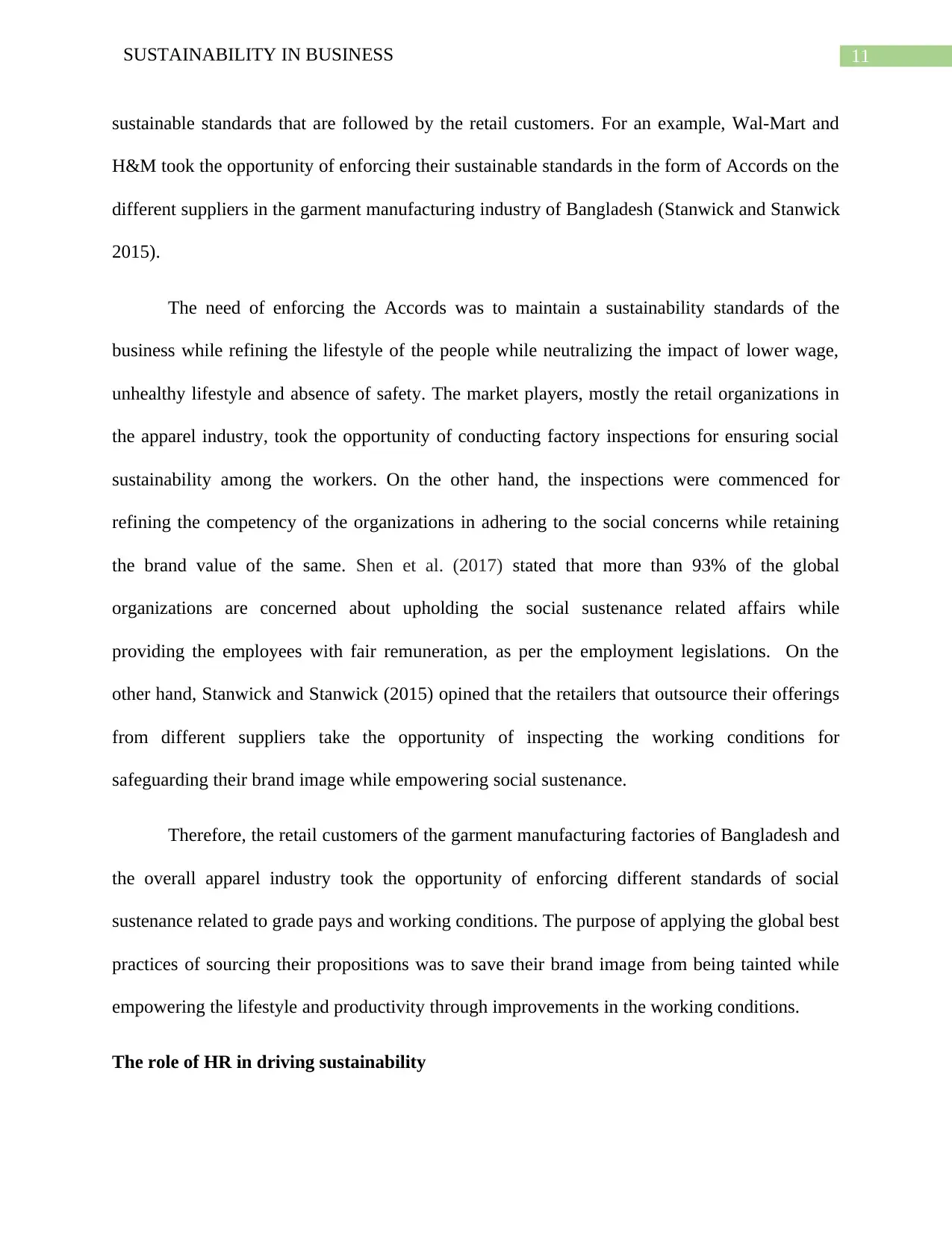
11SUSTAINABILITY IN BUSINESS
sustainable standards that are followed by the retail customers. For an example, Wal-Mart and
H&M took the opportunity of enforcing their sustainable standards in the form of Accords on the
different suppliers in the garment manufacturing industry of Bangladesh (Stanwick and Stanwick
2015).
The need of enforcing the Accords was to maintain a sustainability standards of the
business while refining the lifestyle of the people while neutralizing the impact of lower wage,
unhealthy lifestyle and absence of safety. The market players, mostly the retail organizations in
the apparel industry, took the opportunity of conducting factory inspections for ensuring social
sustainability among the workers. On the other hand, the inspections were commenced for
refining the competency of the organizations in adhering to the social concerns while retaining
the brand value of the same. Shen et al. (2017) stated that more than 93% of the global
organizations are concerned about upholding the social sustenance related affairs while
providing the employees with fair remuneration, as per the employment legislations. On the
other hand, Stanwick and Stanwick (2015) opined that the retailers that outsource their offerings
from different suppliers take the opportunity of inspecting the working conditions for
safeguarding their brand image while empowering social sustenance.
Therefore, the retail customers of the garment manufacturing factories of Bangladesh and
the overall apparel industry took the opportunity of enforcing different standards of social
sustenance related to grade pays and working conditions. The purpose of applying the global best
practices of sourcing their propositions was to save their brand image from being tainted while
empowering the lifestyle and productivity through improvements in the working conditions.
The role of HR in driving sustainability
sustainable standards that are followed by the retail customers. For an example, Wal-Mart and
H&M took the opportunity of enforcing their sustainable standards in the form of Accords on the
different suppliers in the garment manufacturing industry of Bangladesh (Stanwick and Stanwick
2015).
The need of enforcing the Accords was to maintain a sustainability standards of the
business while refining the lifestyle of the people while neutralizing the impact of lower wage,
unhealthy lifestyle and absence of safety. The market players, mostly the retail organizations in
the apparel industry, took the opportunity of conducting factory inspections for ensuring social
sustainability among the workers. On the other hand, the inspections were commenced for
refining the competency of the organizations in adhering to the social concerns while retaining
the brand value of the same. Shen et al. (2017) stated that more than 93% of the global
organizations are concerned about upholding the social sustenance related affairs while
providing the employees with fair remuneration, as per the employment legislations. On the
other hand, Stanwick and Stanwick (2015) opined that the retailers that outsource their offerings
from different suppliers take the opportunity of inspecting the working conditions for
safeguarding their brand image while empowering social sustenance.
Therefore, the retail customers of the garment manufacturing factories of Bangladesh and
the overall apparel industry took the opportunity of enforcing different standards of social
sustenance related to grade pays and working conditions. The purpose of applying the global best
practices of sourcing their propositions was to save their brand image from being tainted while
empowering the lifestyle and productivity through improvements in the working conditions.
The role of HR in driving sustainability
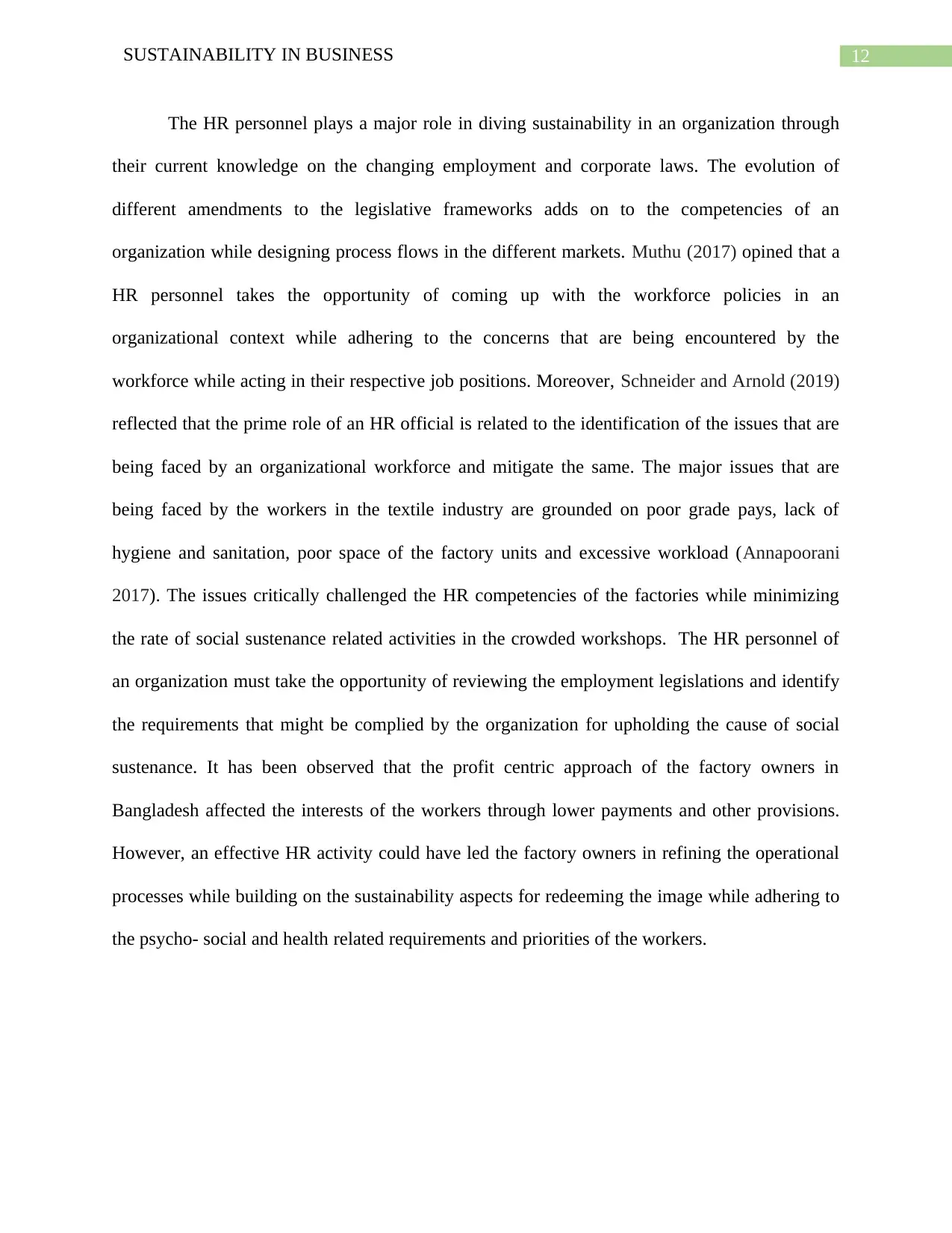
12SUSTAINABILITY IN BUSINESS
The HR personnel plays a major role in diving sustainability in an organization through
their current knowledge on the changing employment and corporate laws. The evolution of
different amendments to the legislative frameworks adds on to the competencies of an
organization while designing process flows in the different markets. Muthu (2017) opined that a
HR personnel takes the opportunity of coming up with the workforce policies in an
organizational context while adhering to the concerns that are being encountered by the
workforce while acting in their respective job positions. Moreover, Schneider and Arnold (2019)
reflected that the prime role of an HR official is related to the identification of the issues that are
being faced by an organizational workforce and mitigate the same. The major issues that are
being faced by the workers in the textile industry are grounded on poor grade pays, lack of
hygiene and sanitation, poor space of the factory units and excessive workload (Annapoorani
2017). The issues critically challenged the HR competencies of the factories while minimizing
the rate of social sustenance related activities in the crowded workshops. The HR personnel of
an organization must take the opportunity of reviewing the employment legislations and identify
the requirements that might be complied by the organization for upholding the cause of social
sustenance. It has been observed that the profit centric approach of the factory owners in
Bangladesh affected the interests of the workers through lower payments and other provisions.
However, an effective HR activity could have led the factory owners in refining the operational
processes while building on the sustainability aspects for redeeming the image while adhering to
the psycho- social and health related requirements and priorities of the workers.
The HR personnel plays a major role in diving sustainability in an organization through
their current knowledge on the changing employment and corporate laws. The evolution of
different amendments to the legislative frameworks adds on to the competencies of an
organization while designing process flows in the different markets. Muthu (2017) opined that a
HR personnel takes the opportunity of coming up with the workforce policies in an
organizational context while adhering to the concerns that are being encountered by the
workforce while acting in their respective job positions. Moreover, Schneider and Arnold (2019)
reflected that the prime role of an HR official is related to the identification of the issues that are
being faced by an organizational workforce and mitigate the same. The major issues that are
being faced by the workers in the textile industry are grounded on poor grade pays, lack of
hygiene and sanitation, poor space of the factory units and excessive workload (Annapoorani
2017). The issues critically challenged the HR competencies of the factories while minimizing
the rate of social sustenance related activities in the crowded workshops. The HR personnel of
an organization must take the opportunity of reviewing the employment legislations and identify
the requirements that might be complied by the organization for upholding the cause of social
sustenance. It has been observed that the profit centric approach of the factory owners in
Bangladesh affected the interests of the workers through lower payments and other provisions.
However, an effective HR activity could have led the factory owners in refining the operational
processes while building on the sustainability aspects for redeeming the image while adhering to
the psycho- social and health related requirements and priorities of the workers.
Paraphrase This Document
Need a fresh take? Get an instant paraphrase of this document with our AI Paraphraser
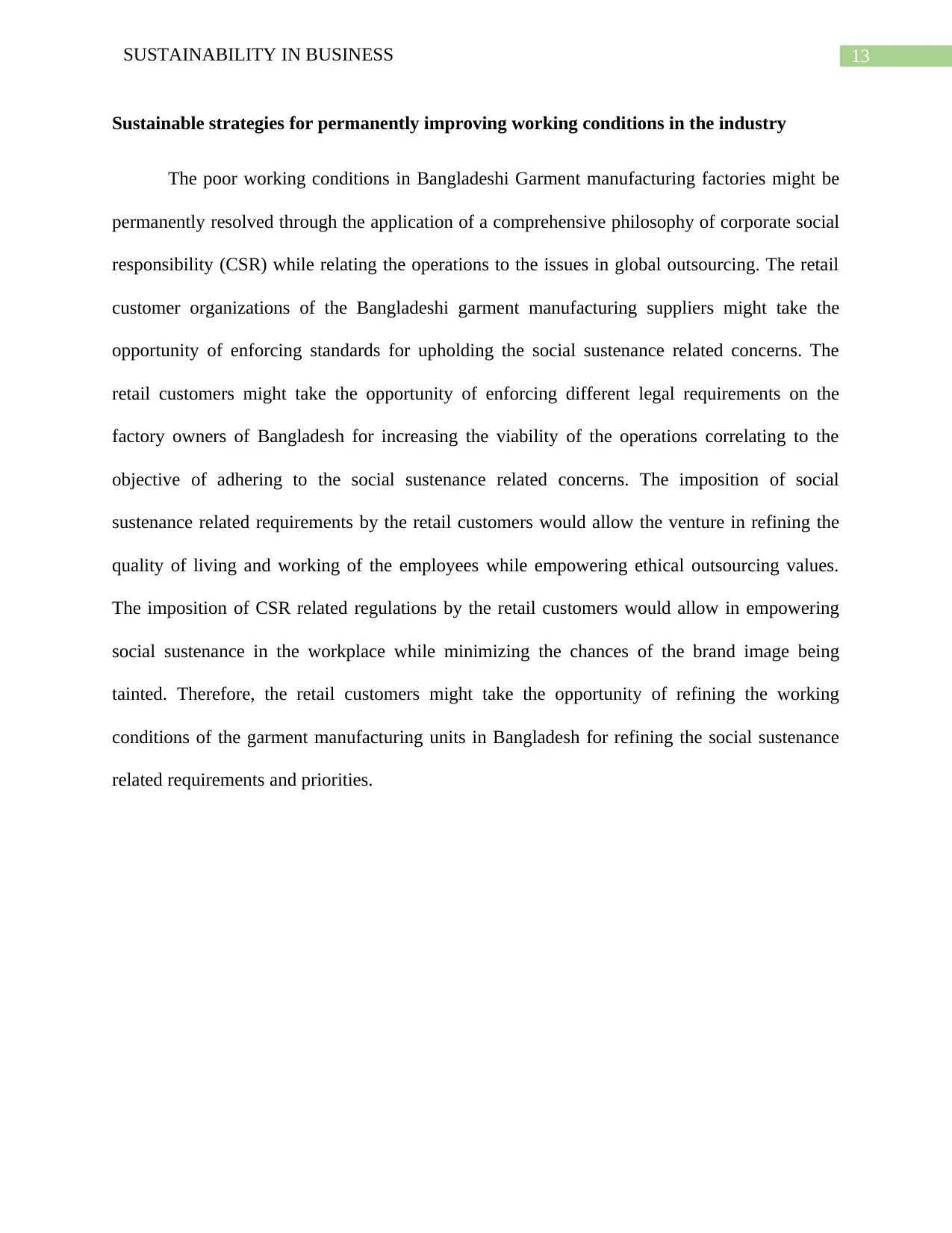
13SUSTAINABILITY IN BUSINESS
Sustainable strategies for permanently improving working conditions in the industry
The poor working conditions in Bangladeshi Garment manufacturing factories might be
permanently resolved through the application of a comprehensive philosophy of corporate social
responsibility (CSR) while relating the operations to the issues in global outsourcing. The retail
customer organizations of the Bangladeshi garment manufacturing suppliers might take the
opportunity of enforcing standards for upholding the social sustenance related concerns. The
retail customers might take the opportunity of enforcing different legal requirements on the
factory owners of Bangladesh for increasing the viability of the operations correlating to the
objective of adhering to the social sustenance related concerns. The imposition of social
sustenance related requirements by the retail customers would allow the venture in refining the
quality of living and working of the employees while empowering ethical outsourcing values.
The imposition of CSR related regulations by the retail customers would allow in empowering
social sustenance in the workplace while minimizing the chances of the brand image being
tainted. Therefore, the retail customers might take the opportunity of refining the working
conditions of the garment manufacturing units in Bangladesh for refining the social sustenance
related requirements and priorities.
Sustainable strategies for permanently improving working conditions in the industry
The poor working conditions in Bangladeshi Garment manufacturing factories might be
permanently resolved through the application of a comprehensive philosophy of corporate social
responsibility (CSR) while relating the operations to the issues in global outsourcing. The retail
customer organizations of the Bangladeshi garment manufacturing suppliers might take the
opportunity of enforcing standards for upholding the social sustenance related concerns. The
retail customers might take the opportunity of enforcing different legal requirements on the
factory owners of Bangladesh for increasing the viability of the operations correlating to the
objective of adhering to the social sustenance related concerns. The imposition of social
sustenance related requirements by the retail customers would allow the venture in refining the
quality of living and working of the employees while empowering ethical outsourcing values.
The imposition of CSR related regulations by the retail customers would allow in empowering
social sustenance in the workplace while minimizing the chances of the brand image being
tainted. Therefore, the retail customers might take the opportunity of refining the working
conditions of the garment manufacturing units in Bangladesh for refining the social sustenance
related requirements and priorities.
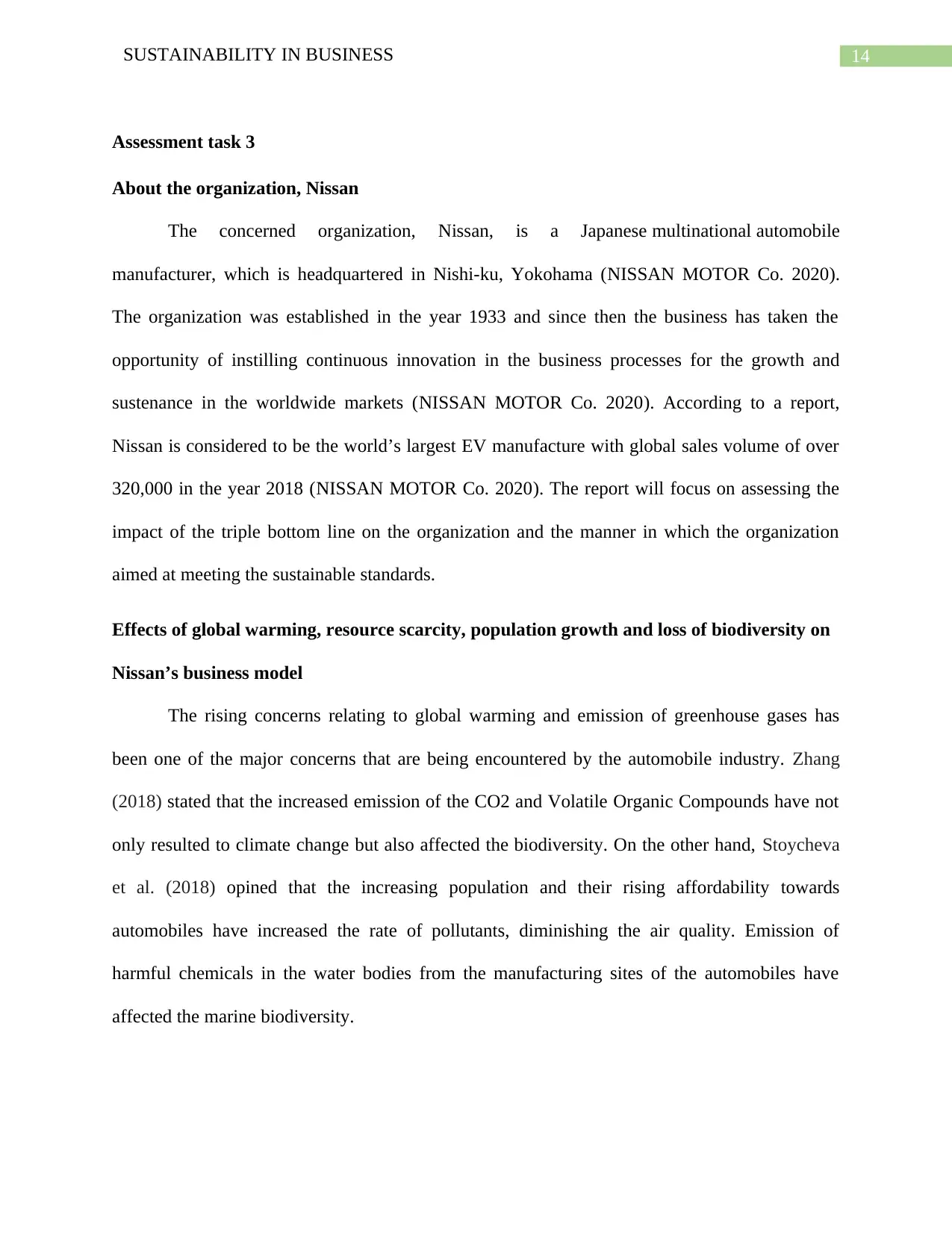
14SUSTAINABILITY IN BUSINESS
Assessment task 3
About the organization, Nissan
The concerned organization, Nissan, is a Japanese multinational automobile
manufacturer, which is headquartered in Nishi-ku, Yokohama (NISSAN MOTOR Co. 2020).
The organization was established in the year 1933 and since then the business has taken the
opportunity of instilling continuous innovation in the business processes for the growth and
sustenance in the worldwide markets (NISSAN MOTOR Co. 2020). According to a report,
Nissan is considered to be the world’s largest EV manufacture with global sales volume of over
320,000 in the year 2018 (NISSAN MOTOR Co. 2020). The report will focus on assessing the
impact of the triple bottom line on the organization and the manner in which the organization
aimed at meeting the sustainable standards.
Effects of global warming, resource scarcity, population growth and loss of biodiversity on
Nissan’s business model
The rising concerns relating to global warming and emission of greenhouse gases has
been one of the major concerns that are being encountered by the automobile industry. Zhang
(2018) stated that the increased emission of the CO2 and Volatile Organic Compounds have not
only resulted to climate change but also affected the biodiversity. On the other hand, Stoycheva
et al. (2018) opined that the increasing population and their rising affordability towards
automobiles have increased the rate of pollutants, diminishing the air quality. Emission of
harmful chemicals in the water bodies from the manufacturing sites of the automobiles have
affected the marine biodiversity.
Assessment task 3
About the organization, Nissan
The concerned organization, Nissan, is a Japanese multinational automobile
manufacturer, which is headquartered in Nishi-ku, Yokohama (NISSAN MOTOR Co. 2020).
The organization was established in the year 1933 and since then the business has taken the
opportunity of instilling continuous innovation in the business processes for the growth and
sustenance in the worldwide markets (NISSAN MOTOR Co. 2020). According to a report,
Nissan is considered to be the world’s largest EV manufacture with global sales volume of over
320,000 in the year 2018 (NISSAN MOTOR Co. 2020). The report will focus on assessing the
impact of the triple bottom line on the organization and the manner in which the organization
aimed at meeting the sustainable standards.
Effects of global warming, resource scarcity, population growth and loss of biodiversity on
Nissan’s business model
The rising concerns relating to global warming and emission of greenhouse gases has
been one of the major concerns that are being encountered by the automobile industry. Zhang
(2018) stated that the increased emission of the CO2 and Volatile Organic Compounds have not
only resulted to climate change but also affected the biodiversity. On the other hand, Stoycheva
et al. (2018) opined that the increasing population and their rising affordability towards
automobiles have increased the rate of pollutants, diminishing the air quality. Emission of
harmful chemicals in the water bodies from the manufacturing sites of the automobiles have
affected the marine biodiversity.
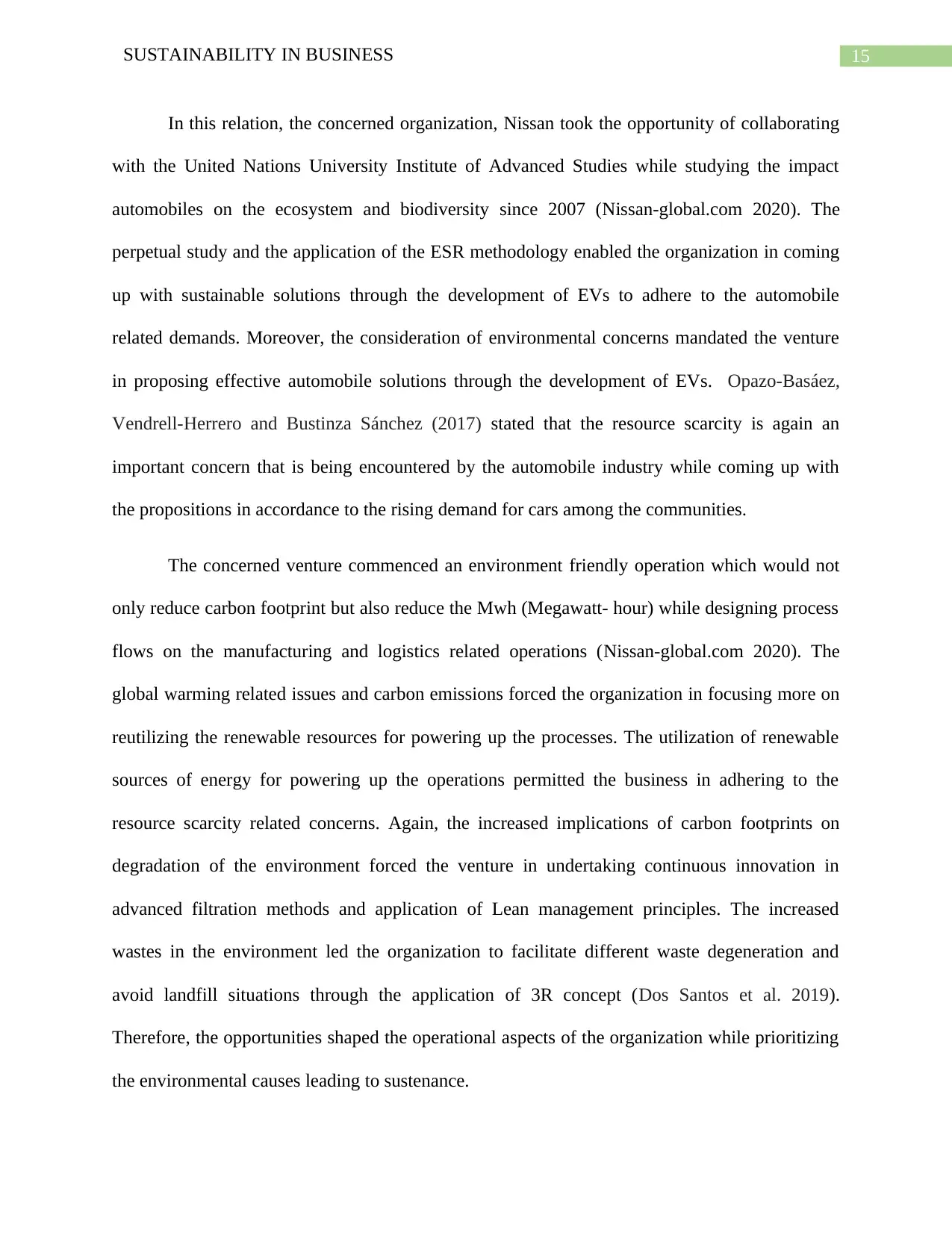
15SUSTAINABILITY IN BUSINESS
In this relation, the concerned organization, Nissan took the opportunity of collaborating
with the United Nations University Institute of Advanced Studies while studying the impact
automobiles on the ecosystem and biodiversity since 2007 (Nissan-global.com 2020). The
perpetual study and the application of the ESR methodology enabled the organization in coming
up with sustainable solutions through the development of EVs to adhere to the automobile
related demands. Moreover, the consideration of environmental concerns mandated the venture
in proposing effective automobile solutions through the development of EVs. Opazo-Basáez,
Vendrell-Herrero and Bustinza Sánchez (2017) stated that the resource scarcity is again an
important concern that is being encountered by the automobile industry while coming up with
the propositions in accordance to the rising demand for cars among the communities.
The concerned venture commenced an environment friendly operation which would not
only reduce carbon footprint but also reduce the Mwh (Megawatt- hour) while designing process
flows on the manufacturing and logistics related operations (Nissan-global.com 2020). The
global warming related issues and carbon emissions forced the organization in focusing more on
reutilizing the renewable resources for powering up the processes. The utilization of renewable
sources of energy for powering up the operations permitted the business in adhering to the
resource scarcity related concerns. Again, the increased implications of carbon footprints on
degradation of the environment forced the venture in undertaking continuous innovation in
advanced filtration methods and application of Lean management principles. The increased
wastes in the environment led the organization to facilitate different waste degeneration and
avoid landfill situations through the application of 3R concept (Dos Santos et al. 2019).
Therefore, the opportunities shaped the operational aspects of the organization while prioritizing
the environmental causes leading to sustenance.
In this relation, the concerned organization, Nissan took the opportunity of collaborating
with the United Nations University Institute of Advanced Studies while studying the impact
automobiles on the ecosystem and biodiversity since 2007 (Nissan-global.com 2020). The
perpetual study and the application of the ESR methodology enabled the organization in coming
up with sustainable solutions through the development of EVs to adhere to the automobile
related demands. Moreover, the consideration of environmental concerns mandated the venture
in proposing effective automobile solutions through the development of EVs. Opazo-Basáez,
Vendrell-Herrero and Bustinza Sánchez (2017) stated that the resource scarcity is again an
important concern that is being encountered by the automobile industry while coming up with
the propositions in accordance to the rising demand for cars among the communities.
The concerned venture commenced an environment friendly operation which would not
only reduce carbon footprint but also reduce the Mwh (Megawatt- hour) while designing process
flows on the manufacturing and logistics related operations (Nissan-global.com 2020). The
global warming related issues and carbon emissions forced the organization in focusing more on
reutilizing the renewable resources for powering up the processes. The utilization of renewable
sources of energy for powering up the operations permitted the business in adhering to the
resource scarcity related concerns. Again, the increased implications of carbon footprints on
degradation of the environment forced the venture in undertaking continuous innovation in
advanced filtration methods and application of Lean management principles. The increased
wastes in the environment led the organization to facilitate different waste degeneration and
avoid landfill situations through the application of 3R concept (Dos Santos et al. 2019).
Therefore, the opportunities shaped the operational aspects of the organization while prioritizing
the environmental causes leading to sustenance.
Secure Best Marks with AI Grader
Need help grading? Try our AI Grader for instant feedback on your assignments.
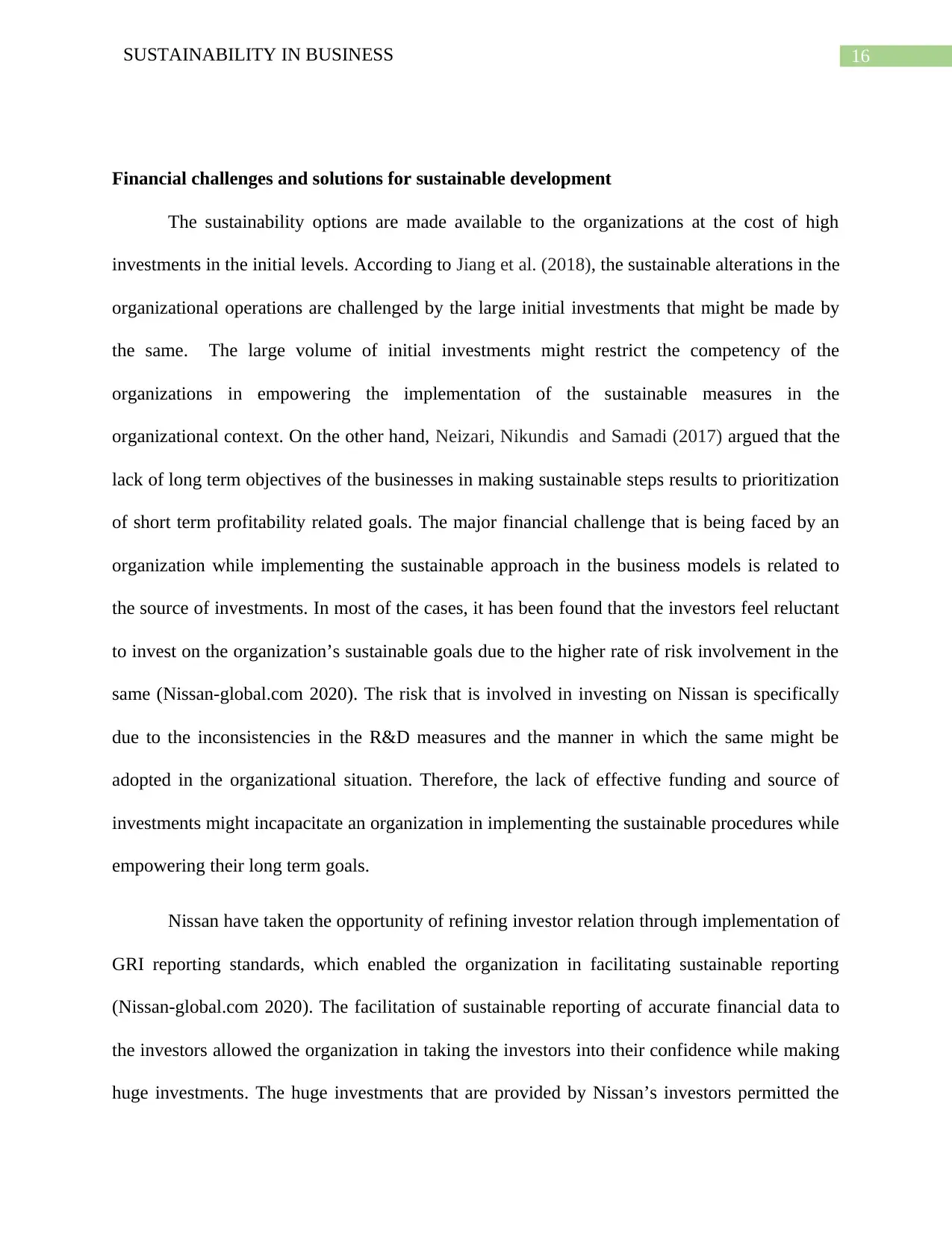
16SUSTAINABILITY IN BUSINESS
Financial challenges and solutions for sustainable development
The sustainability options are made available to the organizations at the cost of high
investments in the initial levels. According to Jiang et al. (2018), the sustainable alterations in the
organizational operations are challenged by the large initial investments that might be made by
the same. The large volume of initial investments might restrict the competency of the
organizations in empowering the implementation of the sustainable measures in the
organizational context. On the other hand, Neizari, Nikundis and Samadi (2017) argued that the
lack of long term objectives of the businesses in making sustainable steps results to prioritization
of short term profitability related goals. The major financial challenge that is being faced by an
organization while implementing the sustainable approach in the business models is related to
the source of investments. In most of the cases, it has been found that the investors feel reluctant
to invest on the organization’s sustainable goals due to the higher rate of risk involvement in the
same (Nissan-global.com 2020). The risk that is involved in investing on Nissan is specifically
due to the inconsistencies in the R&D measures and the manner in which the same might be
adopted in the organizational situation. Therefore, the lack of effective funding and source of
investments might incapacitate an organization in implementing the sustainable procedures while
empowering their long term goals.
Nissan have taken the opportunity of refining investor relation through implementation of
GRI reporting standards, which enabled the organization in facilitating sustainable reporting
(Nissan-global.com 2020). The facilitation of sustainable reporting of accurate financial data to
the investors allowed the organization in taking the investors into their confidence while making
huge investments. The huge investments that are provided by Nissan’s investors permitted the
Financial challenges and solutions for sustainable development
The sustainability options are made available to the organizations at the cost of high
investments in the initial levels. According to Jiang et al. (2018), the sustainable alterations in the
organizational operations are challenged by the large initial investments that might be made by
the same. The large volume of initial investments might restrict the competency of the
organizations in empowering the implementation of the sustainable measures in the
organizational context. On the other hand, Neizari, Nikundis and Samadi (2017) argued that the
lack of long term objectives of the businesses in making sustainable steps results to prioritization
of short term profitability related goals. The major financial challenge that is being faced by an
organization while implementing the sustainable approach in the business models is related to
the source of investments. In most of the cases, it has been found that the investors feel reluctant
to invest on the organization’s sustainable goals due to the higher rate of risk involvement in the
same (Nissan-global.com 2020). The risk that is involved in investing on Nissan is specifically
due to the inconsistencies in the R&D measures and the manner in which the same might be
adopted in the organizational situation. Therefore, the lack of effective funding and source of
investments might incapacitate an organization in implementing the sustainable procedures while
empowering their long term goals.
Nissan have taken the opportunity of refining investor relation through implementation of
GRI reporting standards, which enabled the organization in facilitating sustainable reporting
(Nissan-global.com 2020). The facilitation of sustainable reporting of accurate financial data to
the investors allowed the organization in taking the investors into their confidence while making
huge investments. The huge investments that are provided by Nissan’s investors permitted the
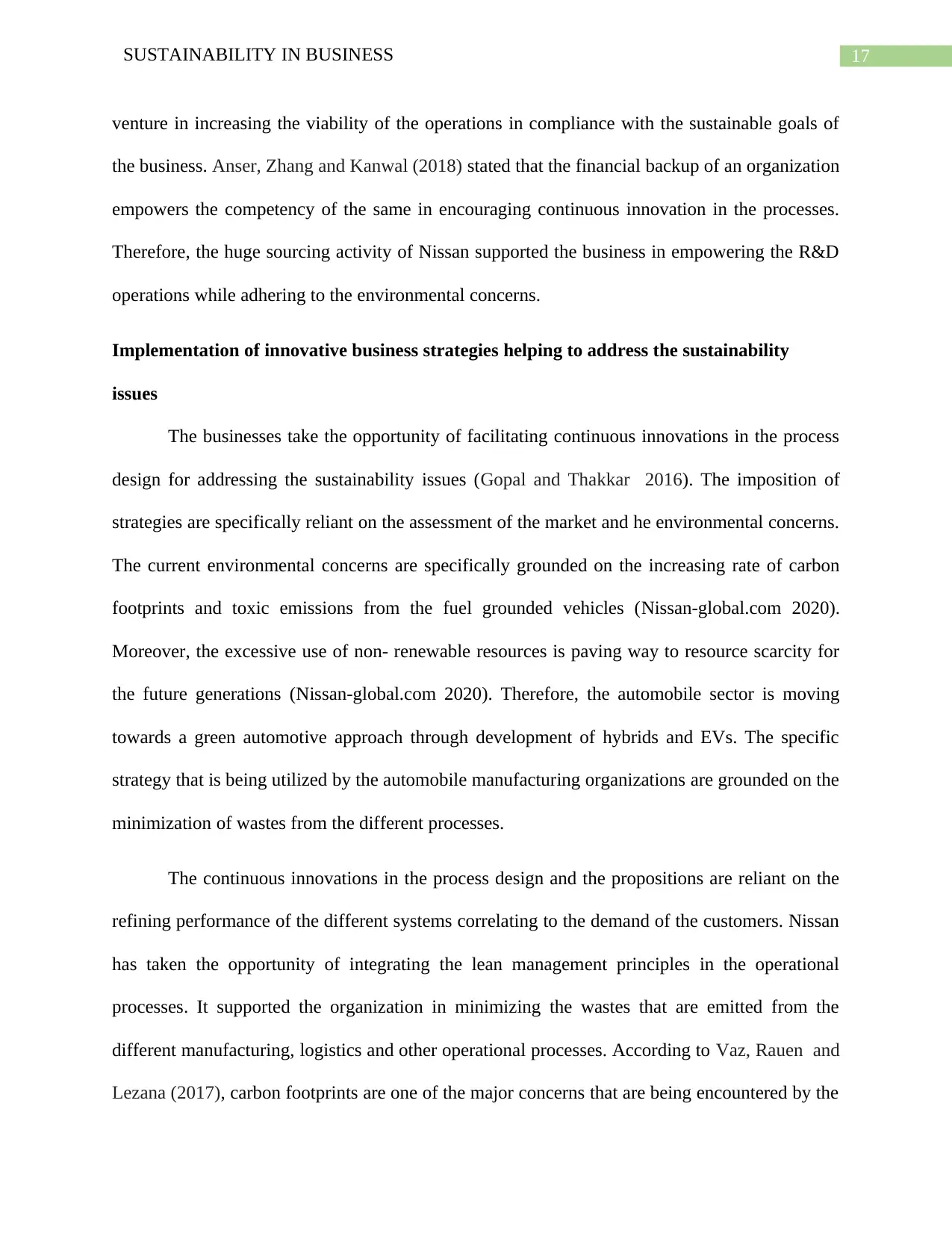
17SUSTAINABILITY IN BUSINESS
venture in increasing the viability of the operations in compliance with the sustainable goals of
the business. Anser, Zhang and Kanwal (2018) stated that the financial backup of an organization
empowers the competency of the same in encouraging continuous innovation in the processes.
Therefore, the huge sourcing activity of Nissan supported the business in empowering the R&D
operations while adhering to the environmental concerns.
Implementation of innovative business strategies helping to address the sustainability
issues
The businesses take the opportunity of facilitating continuous innovations in the process
design for addressing the sustainability issues (Gopal and Thakkar 2016). The imposition of
strategies are specifically reliant on the assessment of the market and he environmental concerns.
The current environmental concerns are specifically grounded on the increasing rate of carbon
footprints and toxic emissions from the fuel grounded vehicles (Nissan-global.com 2020).
Moreover, the excessive use of non- renewable resources is paving way to resource scarcity for
the future generations (Nissan-global.com 2020). Therefore, the automobile sector is moving
towards a green automotive approach through development of hybrids and EVs. The specific
strategy that is being utilized by the automobile manufacturing organizations are grounded on the
minimization of wastes from the different processes.
The continuous innovations in the process design and the propositions are reliant on the
refining performance of the different systems correlating to the demand of the customers. Nissan
has taken the opportunity of integrating the lean management principles in the operational
processes. It supported the organization in minimizing the wastes that are emitted from the
different manufacturing, logistics and other operational processes. According to Vaz, Rauen and
Lezana (2017), carbon footprints are one of the major concerns that are being encountered by the
venture in increasing the viability of the operations in compliance with the sustainable goals of
the business. Anser, Zhang and Kanwal (2018) stated that the financial backup of an organization
empowers the competency of the same in encouraging continuous innovation in the processes.
Therefore, the huge sourcing activity of Nissan supported the business in empowering the R&D
operations while adhering to the environmental concerns.
Implementation of innovative business strategies helping to address the sustainability
issues
The businesses take the opportunity of facilitating continuous innovations in the process
design for addressing the sustainability issues (Gopal and Thakkar 2016). The imposition of
strategies are specifically reliant on the assessment of the market and he environmental concerns.
The current environmental concerns are specifically grounded on the increasing rate of carbon
footprints and toxic emissions from the fuel grounded vehicles (Nissan-global.com 2020).
Moreover, the excessive use of non- renewable resources is paving way to resource scarcity for
the future generations (Nissan-global.com 2020). Therefore, the automobile sector is moving
towards a green automotive approach through development of hybrids and EVs. The specific
strategy that is being utilized by the automobile manufacturing organizations are grounded on the
minimization of wastes from the different processes.
The continuous innovations in the process design and the propositions are reliant on the
refining performance of the different systems correlating to the demand of the customers. Nissan
has taken the opportunity of integrating the lean management principles in the operational
processes. It supported the organization in minimizing the wastes that are emitted from the
different manufacturing, logistics and other operational processes. According to Vaz, Rauen and
Lezana (2017), carbon footprints are one of the major concerns that are being encountered by the
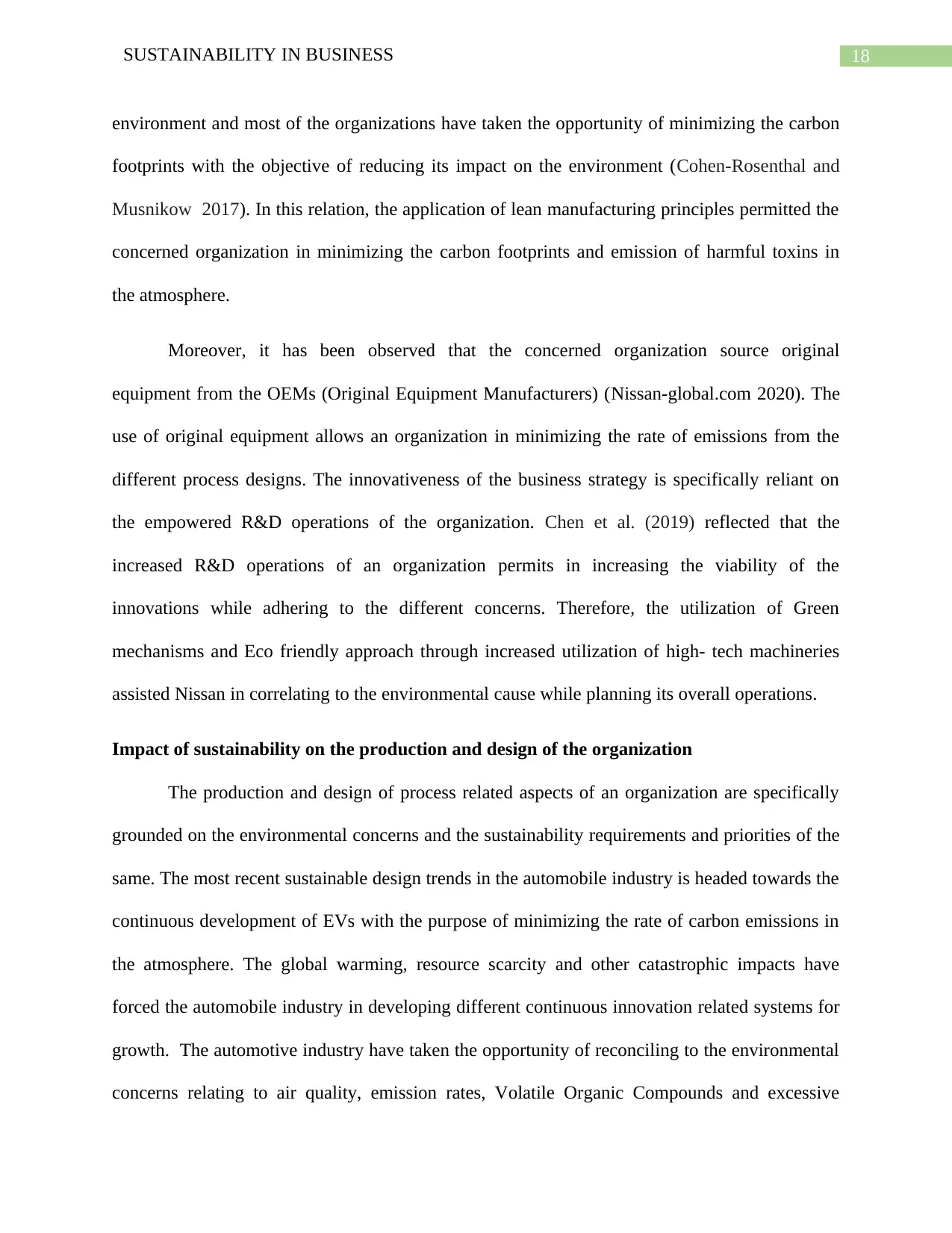
18SUSTAINABILITY IN BUSINESS
environment and most of the organizations have taken the opportunity of minimizing the carbon
footprints with the objective of reducing its impact on the environment (Cohen-Rosenthal and
Musnikow 2017). In this relation, the application of lean manufacturing principles permitted the
concerned organization in minimizing the carbon footprints and emission of harmful toxins in
the atmosphere.
Moreover, it has been observed that the concerned organization source original
equipment from the OEMs (Original Equipment Manufacturers) (Nissan-global.com 2020). The
use of original equipment allows an organization in minimizing the rate of emissions from the
different process designs. The innovativeness of the business strategy is specifically reliant on
the empowered R&D operations of the organization. Chen et al. (2019) reflected that the
increased R&D operations of an organization permits in increasing the viability of the
innovations while adhering to the different concerns. Therefore, the utilization of Green
mechanisms and Eco friendly approach through increased utilization of high- tech machineries
assisted Nissan in correlating to the environmental cause while planning its overall operations.
Impact of sustainability on the production and design of the organization
The production and design of process related aspects of an organization are specifically
grounded on the environmental concerns and the sustainability requirements and priorities of the
same. The most recent sustainable design trends in the automobile industry is headed towards the
continuous development of EVs with the purpose of minimizing the rate of carbon emissions in
the atmosphere. The global warming, resource scarcity and other catastrophic impacts have
forced the automobile industry in developing different continuous innovation related systems for
growth. The automotive industry have taken the opportunity of reconciling to the environmental
concerns relating to air quality, emission rates, Volatile Organic Compounds and excessive
environment and most of the organizations have taken the opportunity of minimizing the carbon
footprints with the objective of reducing its impact on the environment (Cohen-Rosenthal and
Musnikow 2017). In this relation, the application of lean manufacturing principles permitted the
concerned organization in minimizing the carbon footprints and emission of harmful toxins in
the atmosphere.
Moreover, it has been observed that the concerned organization source original
equipment from the OEMs (Original Equipment Manufacturers) (Nissan-global.com 2020). The
use of original equipment allows an organization in minimizing the rate of emissions from the
different process designs. The innovativeness of the business strategy is specifically reliant on
the empowered R&D operations of the organization. Chen et al. (2019) reflected that the
increased R&D operations of an organization permits in increasing the viability of the
innovations while adhering to the different concerns. Therefore, the utilization of Green
mechanisms and Eco friendly approach through increased utilization of high- tech machineries
assisted Nissan in correlating to the environmental cause while planning its overall operations.
Impact of sustainability on the production and design of the organization
The production and design of process related aspects of an organization are specifically
grounded on the environmental concerns and the sustainability requirements and priorities of the
same. The most recent sustainable design trends in the automobile industry is headed towards the
continuous development of EVs with the purpose of minimizing the rate of carbon emissions in
the atmosphere. The global warming, resource scarcity and other catastrophic impacts have
forced the automobile industry in developing different continuous innovation related systems for
growth. The automotive industry have taken the opportunity of reconciling to the environmental
concerns relating to air quality, emission rates, Volatile Organic Compounds and excessive
Paraphrase This Document
Need a fresh take? Get an instant paraphrase of this document with our AI Paraphraser
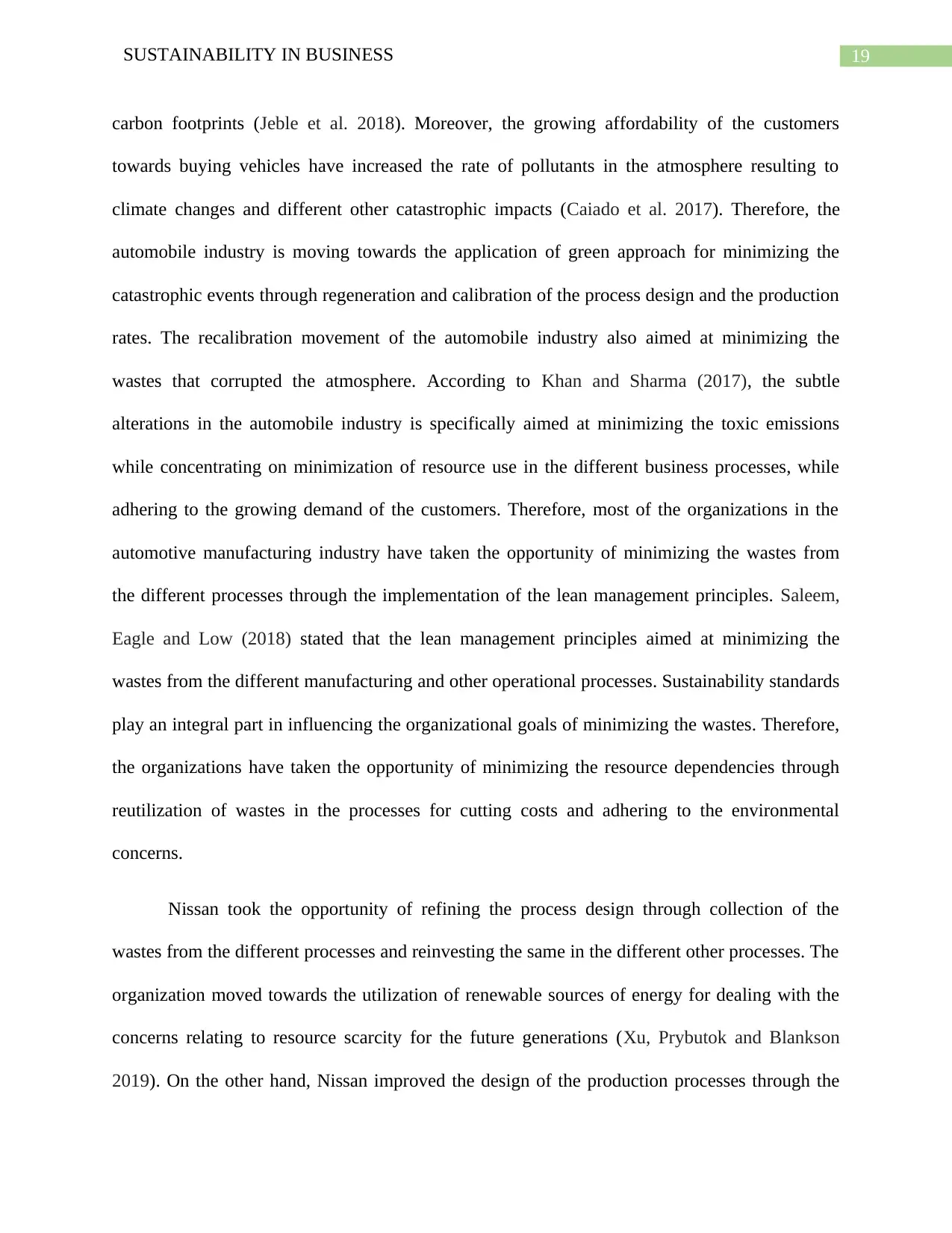
19SUSTAINABILITY IN BUSINESS
carbon footprints (Jeble et al. 2018). Moreover, the growing affordability of the customers
towards buying vehicles have increased the rate of pollutants in the atmosphere resulting to
climate changes and different other catastrophic impacts (Caiado et al. 2017). Therefore, the
automobile industry is moving towards the application of green approach for minimizing the
catastrophic events through regeneration and calibration of the process design and the production
rates. The recalibration movement of the automobile industry also aimed at minimizing the
wastes that corrupted the atmosphere. According to Khan and Sharma (2017), the subtle
alterations in the automobile industry is specifically aimed at minimizing the toxic emissions
while concentrating on minimization of resource use in the different business processes, while
adhering to the growing demand of the customers. Therefore, most of the organizations in the
automotive manufacturing industry have taken the opportunity of minimizing the wastes from
the different processes through the implementation of the lean management principles. Saleem,
Eagle and Low (2018) stated that the lean management principles aimed at minimizing the
wastes from the different manufacturing and other operational processes. Sustainability standards
play an integral part in influencing the organizational goals of minimizing the wastes. Therefore,
the organizations have taken the opportunity of minimizing the resource dependencies through
reutilization of wastes in the processes for cutting costs and adhering to the environmental
concerns.
Nissan took the opportunity of refining the process design through collection of the
wastes from the different processes and reinvesting the same in the different other processes. The
organization moved towards the utilization of renewable sources of energy for dealing with the
concerns relating to resource scarcity for the future generations (Xu, Prybutok and Blankson
2019). On the other hand, Nissan improved the design of the production processes through the
carbon footprints (Jeble et al. 2018). Moreover, the growing affordability of the customers
towards buying vehicles have increased the rate of pollutants in the atmosphere resulting to
climate changes and different other catastrophic impacts (Caiado et al. 2017). Therefore, the
automobile industry is moving towards the application of green approach for minimizing the
catastrophic events through regeneration and calibration of the process design and the production
rates. The recalibration movement of the automobile industry also aimed at minimizing the
wastes that corrupted the atmosphere. According to Khan and Sharma (2017), the subtle
alterations in the automobile industry is specifically aimed at minimizing the toxic emissions
while concentrating on minimization of resource use in the different business processes, while
adhering to the growing demand of the customers. Therefore, most of the organizations in the
automotive manufacturing industry have taken the opportunity of minimizing the wastes from
the different processes through the implementation of the lean management principles. Saleem,
Eagle and Low (2018) stated that the lean management principles aimed at minimizing the
wastes from the different manufacturing and other operational processes. Sustainability standards
play an integral part in influencing the organizational goals of minimizing the wastes. Therefore,
the organizations have taken the opportunity of minimizing the resource dependencies through
reutilization of wastes in the processes for cutting costs and adhering to the environmental
concerns.
Nissan took the opportunity of refining the process design through collection of the
wastes from the different processes and reinvesting the same in the different other processes. The
organization moved towards the utilization of renewable sources of energy for dealing with the
concerns relating to resource scarcity for the future generations (Xu, Prybutok and Blankson
2019). On the other hand, Nissan improved the design of the production processes through the
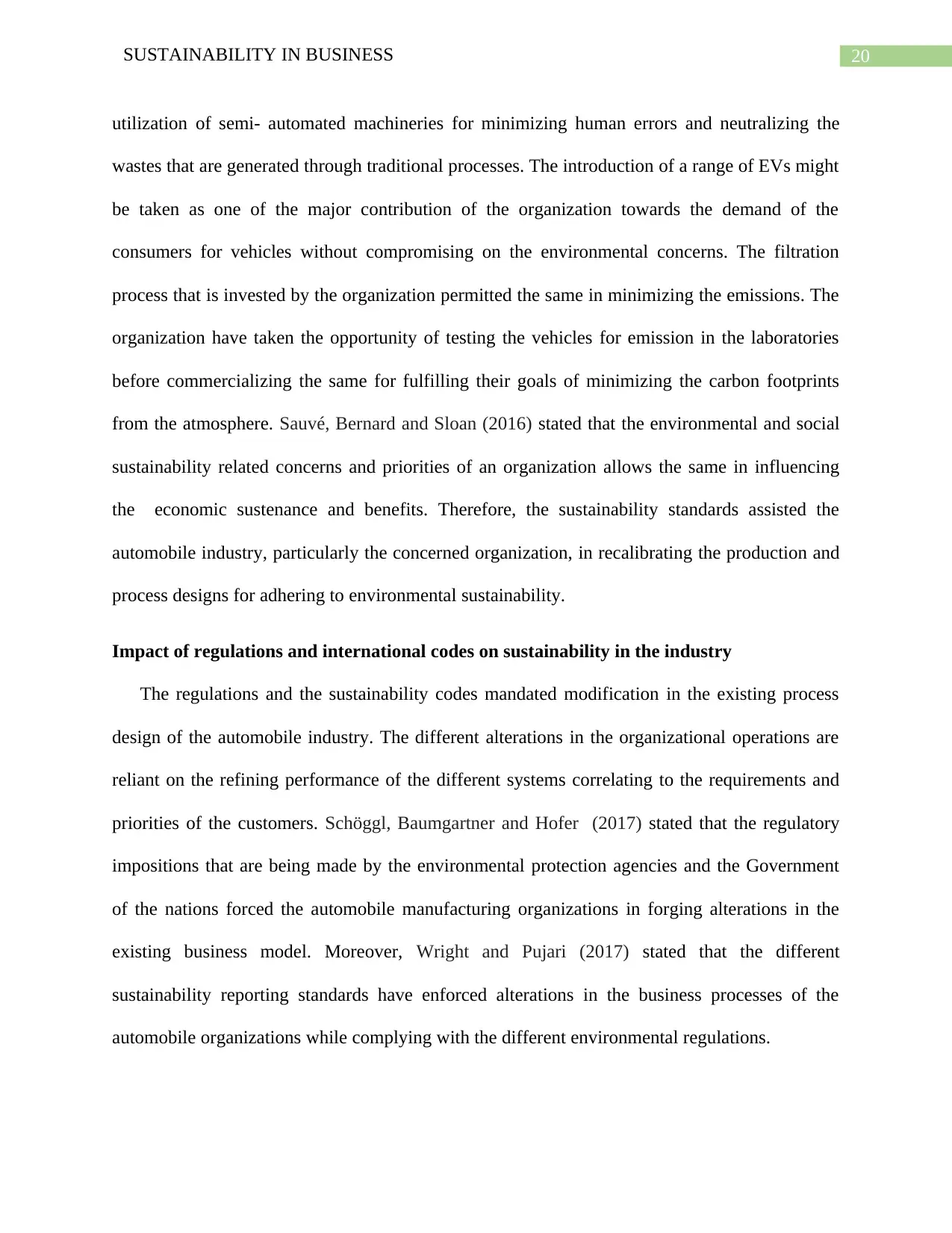
20SUSTAINABILITY IN BUSINESS
utilization of semi- automated machineries for minimizing human errors and neutralizing the
wastes that are generated through traditional processes. The introduction of a range of EVs might
be taken as one of the major contribution of the organization towards the demand of the
consumers for vehicles without compromising on the environmental concerns. The filtration
process that is invested by the organization permitted the same in minimizing the emissions. The
organization have taken the opportunity of testing the vehicles for emission in the laboratories
before commercializing the same for fulfilling their goals of minimizing the carbon footprints
from the atmosphere. Sauvé, Bernard and Sloan (2016) stated that the environmental and social
sustainability related concerns and priorities of an organization allows the same in influencing
the economic sustenance and benefits. Therefore, the sustainability standards assisted the
automobile industry, particularly the concerned organization, in recalibrating the production and
process designs for adhering to environmental sustainability.
Impact of regulations and international codes on sustainability in the industry
The regulations and the sustainability codes mandated modification in the existing process
design of the automobile industry. The different alterations in the organizational operations are
reliant on the refining performance of the different systems correlating to the requirements and
priorities of the customers. Schöggl, Baumgartner and Hofer (2017) stated that the regulatory
impositions that are being made by the environmental protection agencies and the Government
of the nations forced the automobile manufacturing organizations in forging alterations in the
existing business model. Moreover, Wright and Pujari (2017) stated that the different
sustainability reporting standards have enforced alterations in the business processes of the
automobile organizations while complying with the different environmental regulations.
utilization of semi- automated machineries for minimizing human errors and neutralizing the
wastes that are generated through traditional processes. The introduction of a range of EVs might
be taken as one of the major contribution of the organization towards the demand of the
consumers for vehicles without compromising on the environmental concerns. The filtration
process that is invested by the organization permitted the same in minimizing the emissions. The
organization have taken the opportunity of testing the vehicles for emission in the laboratories
before commercializing the same for fulfilling their goals of minimizing the carbon footprints
from the atmosphere. Sauvé, Bernard and Sloan (2016) stated that the environmental and social
sustainability related concerns and priorities of an organization allows the same in influencing
the economic sustenance and benefits. Therefore, the sustainability standards assisted the
automobile industry, particularly the concerned organization, in recalibrating the production and
process designs for adhering to environmental sustainability.
Impact of regulations and international codes on sustainability in the industry
The regulations and the sustainability codes mandated modification in the existing process
design of the automobile industry. The different alterations in the organizational operations are
reliant on the refining performance of the different systems correlating to the requirements and
priorities of the customers. Schöggl, Baumgartner and Hofer (2017) stated that the regulatory
impositions that are being made by the environmental protection agencies and the Government
of the nations forced the automobile manufacturing organizations in forging alterations in the
existing business model. Moreover, Wright and Pujari (2017) stated that the different
sustainability reporting standards have enforced alterations in the business processes of the
automobile organizations while complying with the different environmental regulations.
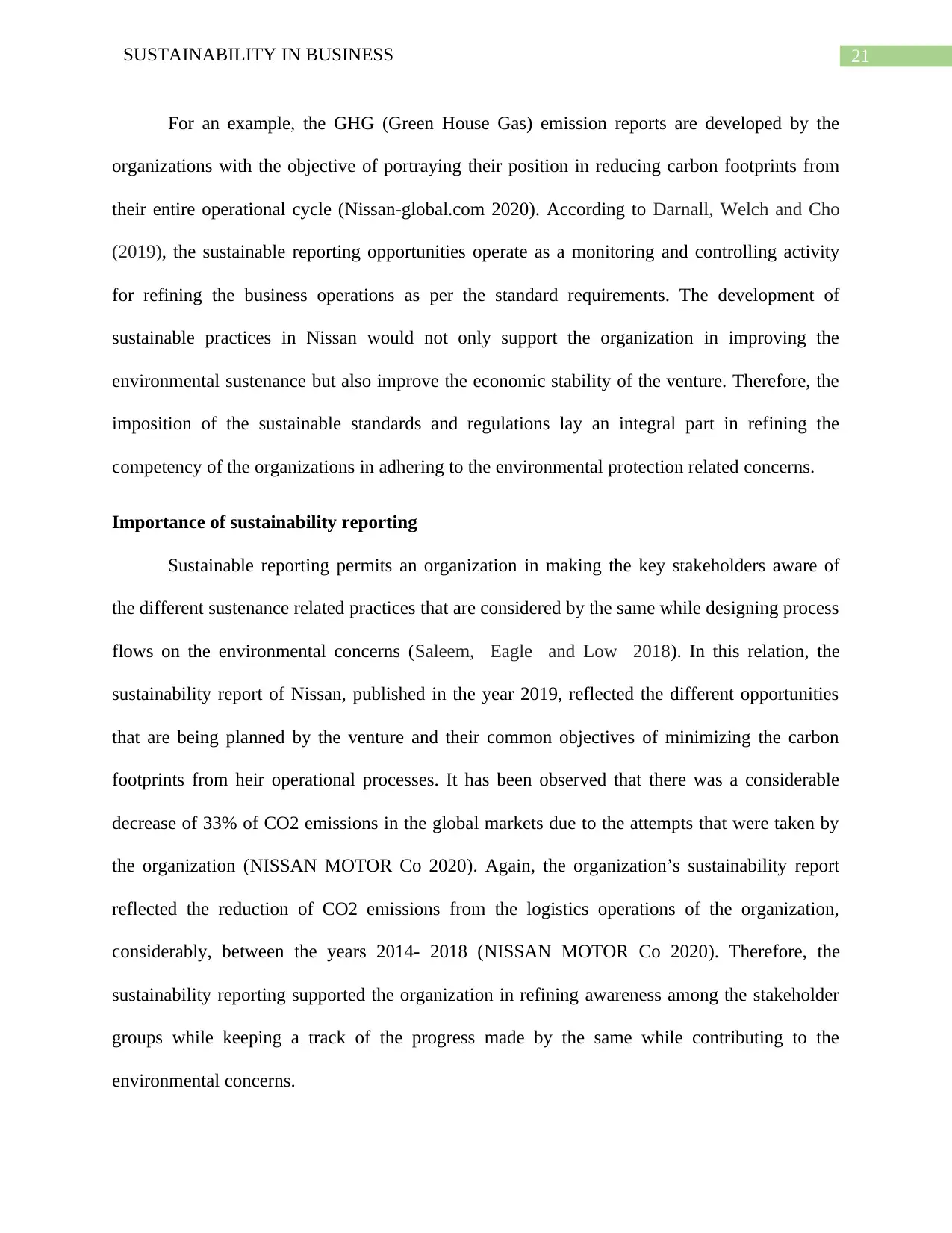
21SUSTAINABILITY IN BUSINESS
For an example, the GHG (Green House Gas) emission reports are developed by the
organizations with the objective of portraying their position in reducing carbon footprints from
their entire operational cycle (Nissan-global.com 2020). According to Darnall, Welch and Cho
(2019), the sustainable reporting opportunities operate as a monitoring and controlling activity
for refining the business operations as per the standard requirements. The development of
sustainable practices in Nissan would not only support the organization in improving the
environmental sustenance but also improve the economic stability of the venture. Therefore, the
imposition of the sustainable standards and regulations lay an integral part in refining the
competency of the organizations in adhering to the environmental protection related concerns.
Importance of sustainability reporting
Sustainable reporting permits an organization in making the key stakeholders aware of
the different sustenance related practices that are considered by the same while designing process
flows on the environmental concerns (Saleem, Eagle and Low 2018). In this relation, the
sustainability report of Nissan, published in the year 2019, reflected the different opportunities
that are being planned by the venture and their common objectives of minimizing the carbon
footprints from heir operational processes. It has been observed that there was a considerable
decrease of 33% of CO2 emissions in the global markets due to the attempts that were taken by
the organization (NISSAN MOTOR Co 2020). Again, the organization’s sustainability report
reflected the reduction of CO2 emissions from the logistics operations of the organization,
considerably, between the years 2014- 2018 (NISSAN MOTOR Co 2020). Therefore, the
sustainability reporting supported the organization in refining awareness among the stakeholder
groups while keeping a track of the progress made by the same while contributing to the
environmental concerns.
For an example, the GHG (Green House Gas) emission reports are developed by the
organizations with the objective of portraying their position in reducing carbon footprints from
their entire operational cycle (Nissan-global.com 2020). According to Darnall, Welch and Cho
(2019), the sustainable reporting opportunities operate as a monitoring and controlling activity
for refining the business operations as per the standard requirements. The development of
sustainable practices in Nissan would not only support the organization in improving the
environmental sustenance but also improve the economic stability of the venture. Therefore, the
imposition of the sustainable standards and regulations lay an integral part in refining the
competency of the organizations in adhering to the environmental protection related concerns.
Importance of sustainability reporting
Sustainable reporting permits an organization in making the key stakeholders aware of
the different sustenance related practices that are considered by the same while designing process
flows on the environmental concerns (Saleem, Eagle and Low 2018). In this relation, the
sustainability report of Nissan, published in the year 2019, reflected the different opportunities
that are being planned by the venture and their common objectives of minimizing the carbon
footprints from heir operational processes. It has been observed that there was a considerable
decrease of 33% of CO2 emissions in the global markets due to the attempts that were taken by
the organization (NISSAN MOTOR Co 2020). Again, the organization’s sustainability report
reflected the reduction of CO2 emissions from the logistics operations of the organization,
considerably, between the years 2014- 2018 (NISSAN MOTOR Co 2020). Therefore, the
sustainability reporting supported the organization in refining awareness among the stakeholder
groups while keeping a track of the progress made by the same while contributing to the
environmental concerns.
Secure Best Marks with AI Grader
Need help grading? Try our AI Grader for instant feedback on your assignments.

22SUSTAINABILITY IN BUSINESS
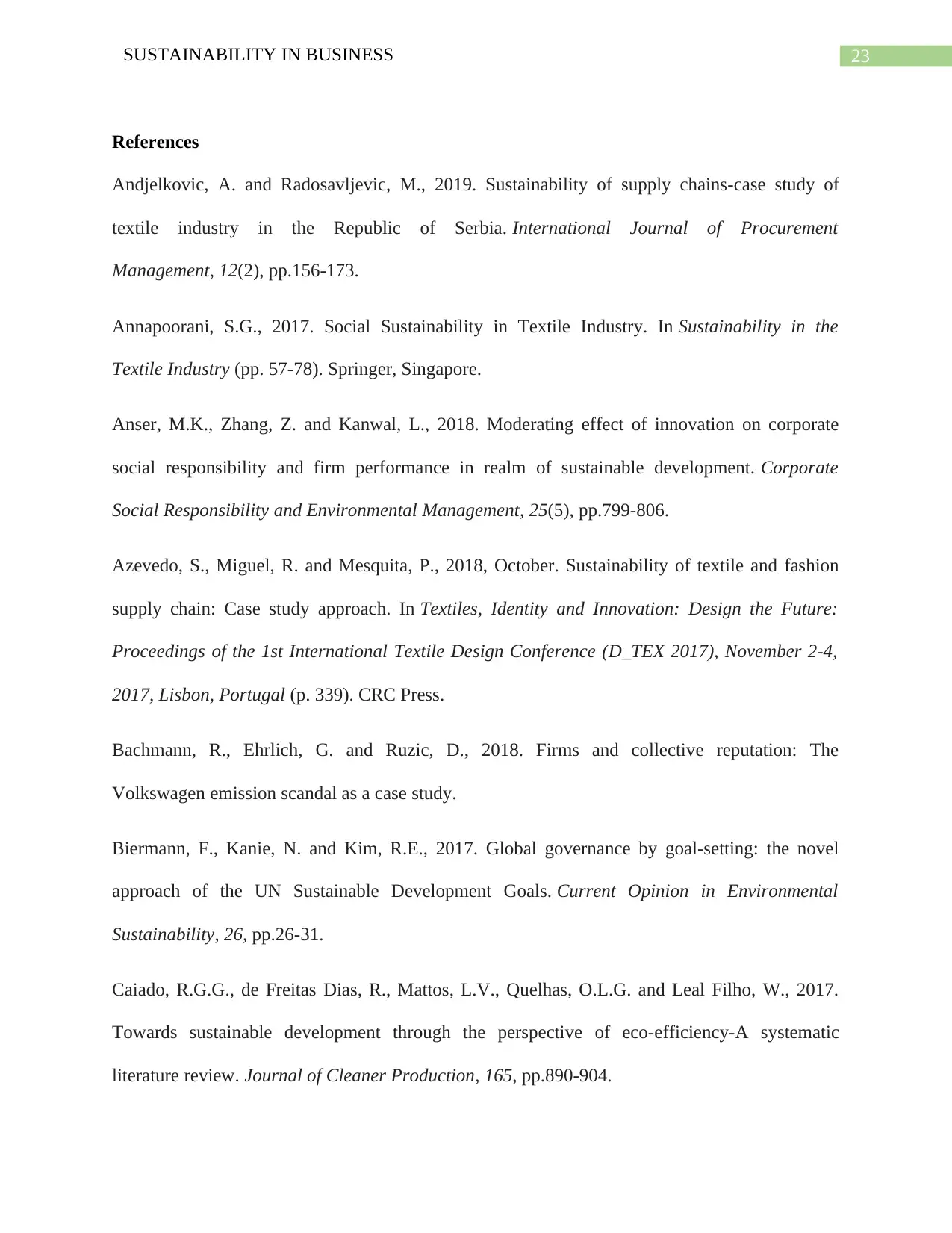
23SUSTAINABILITY IN BUSINESS
References
Andjelkovic, A. and Radosavljevic, M., 2019. Sustainability of supply chains-case study of
textile industry in the Republic of Serbia. International Journal of Procurement
Management, 12(2), pp.156-173.
Annapoorani, S.G., 2017. Social Sustainability in Textile Industry. In Sustainability in the
Textile Industry (pp. 57-78). Springer, Singapore.
Anser, M.K., Zhang, Z. and Kanwal, L., 2018. Moderating effect of innovation on corporate
social responsibility and firm performance in realm of sustainable development. Corporate
Social Responsibility and Environmental Management, 25(5), pp.799-806.
Azevedo, S., Miguel, R. and Mesquita, P., 2018, October. Sustainability of textile and fashion
supply chain: Case study approach. In Textiles, Identity and Innovation: Design the Future:
Proceedings of the 1st International Textile Design Conference (D_TEX 2017), November 2-4,
2017, Lisbon, Portugal (p. 339). CRC Press.
Bachmann, R., Ehrlich, G. and Ruzic, D., 2018. Firms and collective reputation: The
Volkswagen emission scandal as a case study.
Biermann, F., Kanie, N. and Kim, R.E., 2017. Global governance by goal-setting: the novel
approach of the UN Sustainable Development Goals. Current Opinion in Environmental
Sustainability, 26, pp.26-31.
Caiado, R.G.G., de Freitas Dias, R., Mattos, L.V., Quelhas, O.L.G. and Leal Filho, W., 2017.
Towards sustainable development through the perspective of eco-efficiency-A systematic
literature review. Journal of Cleaner Production, 165, pp.890-904.
References
Andjelkovic, A. and Radosavljevic, M., 2019. Sustainability of supply chains-case study of
textile industry in the Republic of Serbia. International Journal of Procurement
Management, 12(2), pp.156-173.
Annapoorani, S.G., 2017. Social Sustainability in Textile Industry. In Sustainability in the
Textile Industry (pp. 57-78). Springer, Singapore.
Anser, M.K., Zhang, Z. and Kanwal, L., 2018. Moderating effect of innovation on corporate
social responsibility and firm performance in realm of sustainable development. Corporate
Social Responsibility and Environmental Management, 25(5), pp.799-806.
Azevedo, S., Miguel, R. and Mesquita, P., 2018, October. Sustainability of textile and fashion
supply chain: Case study approach. In Textiles, Identity and Innovation: Design the Future:
Proceedings of the 1st International Textile Design Conference (D_TEX 2017), November 2-4,
2017, Lisbon, Portugal (p. 339). CRC Press.
Bachmann, R., Ehrlich, G. and Ruzic, D., 2018. Firms and collective reputation: The
Volkswagen emission scandal as a case study.
Biermann, F., Kanie, N. and Kim, R.E., 2017. Global governance by goal-setting: the novel
approach of the UN Sustainable Development Goals. Current Opinion in Environmental
Sustainability, 26, pp.26-31.
Caiado, R.G.G., de Freitas Dias, R., Mattos, L.V., Quelhas, O.L.G. and Leal Filho, W., 2017.
Towards sustainable development through the perspective of eco-efficiency-A systematic
literature review. Journal of Cleaner Production, 165, pp.890-904.
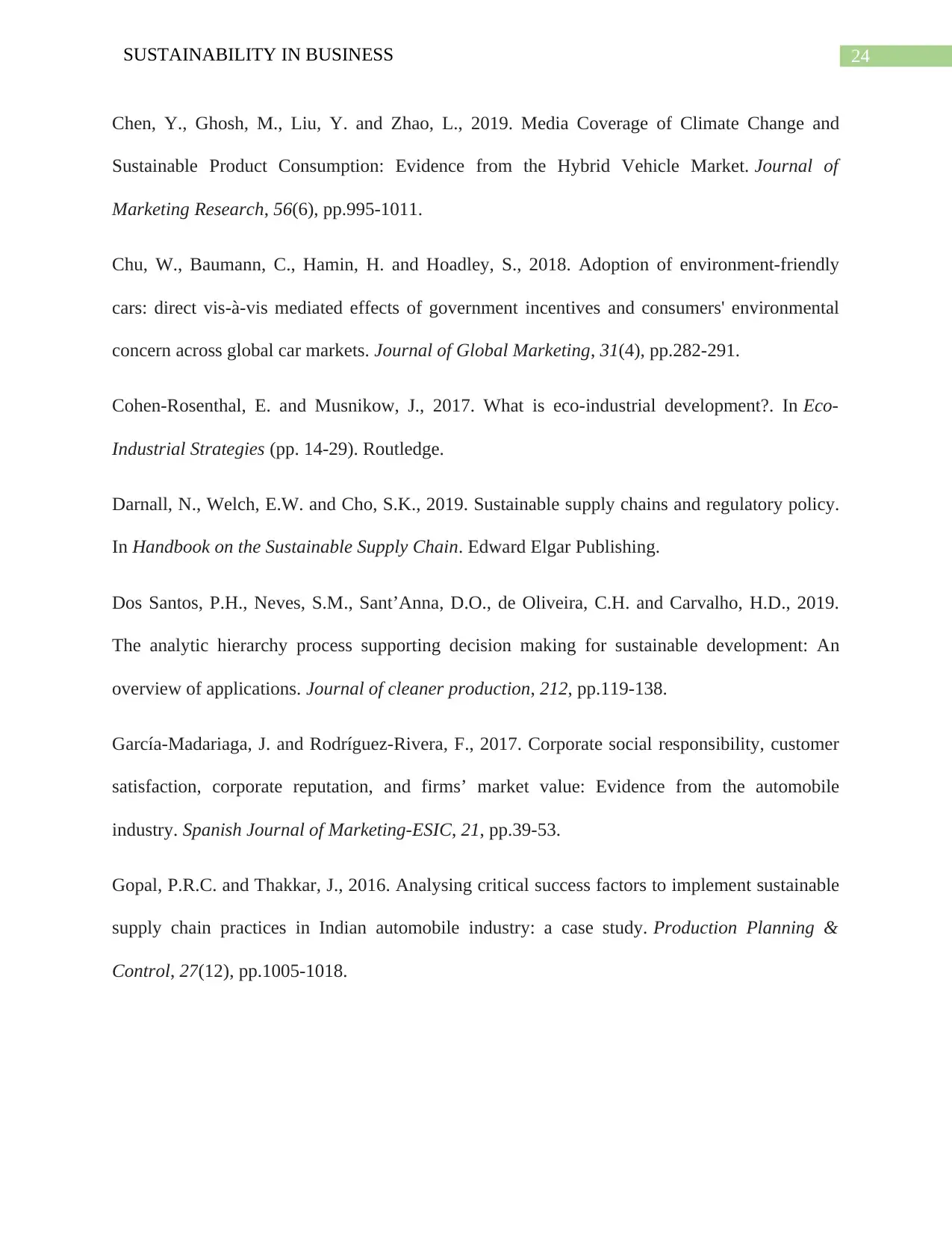
24SUSTAINABILITY IN BUSINESS
Chen, Y., Ghosh, M., Liu, Y. and Zhao, L., 2019. Media Coverage of Climate Change and
Sustainable Product Consumption: Evidence from the Hybrid Vehicle Market. Journal of
Marketing Research, 56(6), pp.995-1011.
Chu, W., Baumann, C., Hamin, H. and Hoadley, S., 2018. Adoption of environment-friendly
cars: direct vis-à-vis mediated effects of government incentives and consumers' environmental
concern across global car markets. Journal of Global Marketing, 31(4), pp.282-291.
Cohen-Rosenthal, E. and Musnikow, J., 2017. What is eco-industrial development?. In Eco-
Industrial Strategies (pp. 14-29). Routledge.
Darnall, N., Welch, E.W. and Cho, S.K., 2019. Sustainable supply chains and regulatory policy.
In Handbook on the Sustainable Supply Chain. Edward Elgar Publishing.
Dos Santos, P.H., Neves, S.M., Sant’Anna, D.O., de Oliveira, C.H. and Carvalho, H.D., 2019.
The analytic hierarchy process supporting decision making for sustainable development: An
overview of applications. Journal of cleaner production, 212, pp.119-138.
García-Madariaga, J. and Rodríguez-Rivera, F., 2017. Corporate social responsibility, customer
satisfaction, corporate reputation, and firms’ market value: Evidence from the automobile
industry. Spanish Journal of Marketing-ESIC, 21, pp.39-53.
Gopal, P.R.C. and Thakkar, J., 2016. Analysing critical success factors to implement sustainable
supply chain practices in Indian automobile industry: a case study. Production Planning &
Control, 27(12), pp.1005-1018.
Chen, Y., Ghosh, M., Liu, Y. and Zhao, L., 2019. Media Coverage of Climate Change and
Sustainable Product Consumption: Evidence from the Hybrid Vehicle Market. Journal of
Marketing Research, 56(6), pp.995-1011.
Chu, W., Baumann, C., Hamin, H. and Hoadley, S., 2018. Adoption of environment-friendly
cars: direct vis-à-vis mediated effects of government incentives and consumers' environmental
concern across global car markets. Journal of Global Marketing, 31(4), pp.282-291.
Cohen-Rosenthal, E. and Musnikow, J., 2017. What is eco-industrial development?. In Eco-
Industrial Strategies (pp. 14-29). Routledge.
Darnall, N., Welch, E.W. and Cho, S.K., 2019. Sustainable supply chains and regulatory policy.
In Handbook on the Sustainable Supply Chain. Edward Elgar Publishing.
Dos Santos, P.H., Neves, S.M., Sant’Anna, D.O., de Oliveira, C.H. and Carvalho, H.D., 2019.
The analytic hierarchy process supporting decision making for sustainable development: An
overview of applications. Journal of cleaner production, 212, pp.119-138.
García-Madariaga, J. and Rodríguez-Rivera, F., 2017. Corporate social responsibility, customer
satisfaction, corporate reputation, and firms’ market value: Evidence from the automobile
industry. Spanish Journal of Marketing-ESIC, 21, pp.39-53.
Gopal, P.R.C. and Thakkar, J., 2016. Analysing critical success factors to implement sustainable
supply chain practices in Indian automobile industry: a case study. Production Planning &
Control, 27(12), pp.1005-1018.
Paraphrase This Document
Need a fresh take? Get an instant paraphrase of this document with our AI Paraphraser
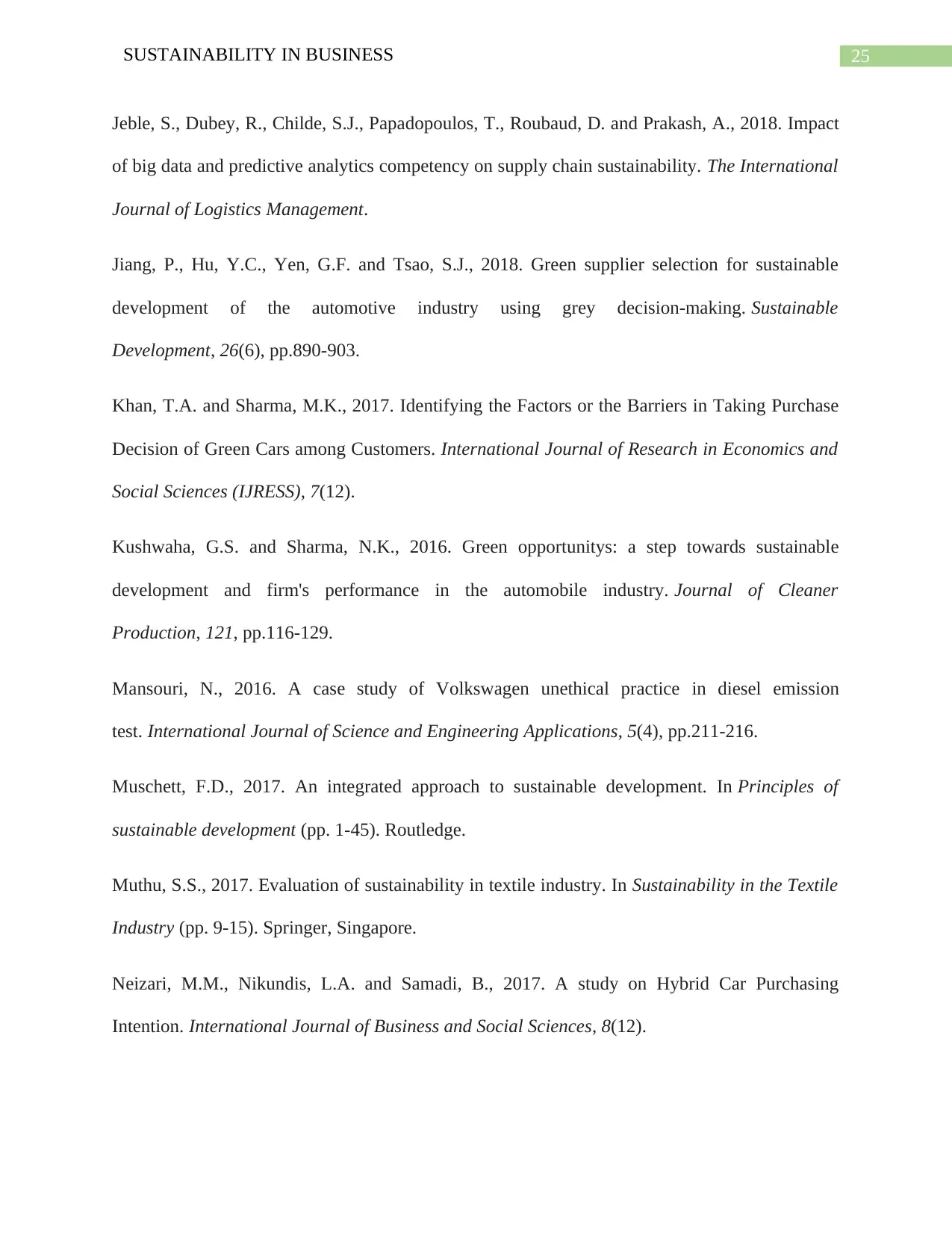
25SUSTAINABILITY IN BUSINESS
Jeble, S., Dubey, R., Childe, S.J., Papadopoulos, T., Roubaud, D. and Prakash, A., 2018. Impact
of big data and predictive analytics competency on supply chain sustainability. The International
Journal of Logistics Management.
Jiang, P., Hu, Y.C., Yen, G.F. and Tsao, S.J., 2018. Green supplier selection for sustainable
development of the automotive industry using grey decision‐making. Sustainable
Development, 26(6), pp.890-903.
Khan, T.A. and Sharma, M.K., 2017. Identifying the Factors or the Barriers in Taking Purchase
Decision of Green Cars among Customers. International Journal of Research in Economics and
Social Sciences (IJRESS), 7(12).
Kushwaha, G.S. and Sharma, N.K., 2016. Green opportunitys: a step towards sustainable
development and firm's performance in the automobile industry. Journal of Cleaner
Production, 121, pp.116-129.
Mansouri, N., 2016. A case study of Volkswagen unethical practice in diesel emission
test. International Journal of Science and Engineering Applications, 5(4), pp.211-216.
Muschett, F.D., 2017. An integrated approach to sustainable development. In Principles of
sustainable development (pp. 1-45). Routledge.
Muthu, S.S., 2017. Evaluation of sustainability in textile industry. In Sustainability in the Textile
Industry (pp. 9-15). Springer, Singapore.
Neizari, M.M., Nikundis, L.A. and Samadi, B., 2017. A study on Hybrid Car Purchasing
Intention. International Journal of Business and Social Sciences, 8(12).
Jeble, S., Dubey, R., Childe, S.J., Papadopoulos, T., Roubaud, D. and Prakash, A., 2018. Impact
of big data and predictive analytics competency on supply chain sustainability. The International
Journal of Logistics Management.
Jiang, P., Hu, Y.C., Yen, G.F. and Tsao, S.J., 2018. Green supplier selection for sustainable
development of the automotive industry using grey decision‐making. Sustainable
Development, 26(6), pp.890-903.
Khan, T.A. and Sharma, M.K., 2017. Identifying the Factors or the Barriers in Taking Purchase
Decision of Green Cars among Customers. International Journal of Research in Economics and
Social Sciences (IJRESS), 7(12).
Kushwaha, G.S. and Sharma, N.K., 2016. Green opportunitys: a step towards sustainable
development and firm's performance in the automobile industry. Journal of Cleaner
Production, 121, pp.116-129.
Mansouri, N., 2016. A case study of Volkswagen unethical practice in diesel emission
test. International Journal of Science and Engineering Applications, 5(4), pp.211-216.
Muschett, F.D., 2017. An integrated approach to sustainable development. In Principles of
sustainable development (pp. 1-45). Routledge.
Muthu, S.S., 2017. Evaluation of sustainability in textile industry. In Sustainability in the Textile
Industry (pp. 9-15). Springer, Singapore.
Neizari, M.M., Nikundis, L.A. and Samadi, B., 2017. A study on Hybrid Car Purchasing
Intention. International Journal of Business and Social Sciences, 8(12).
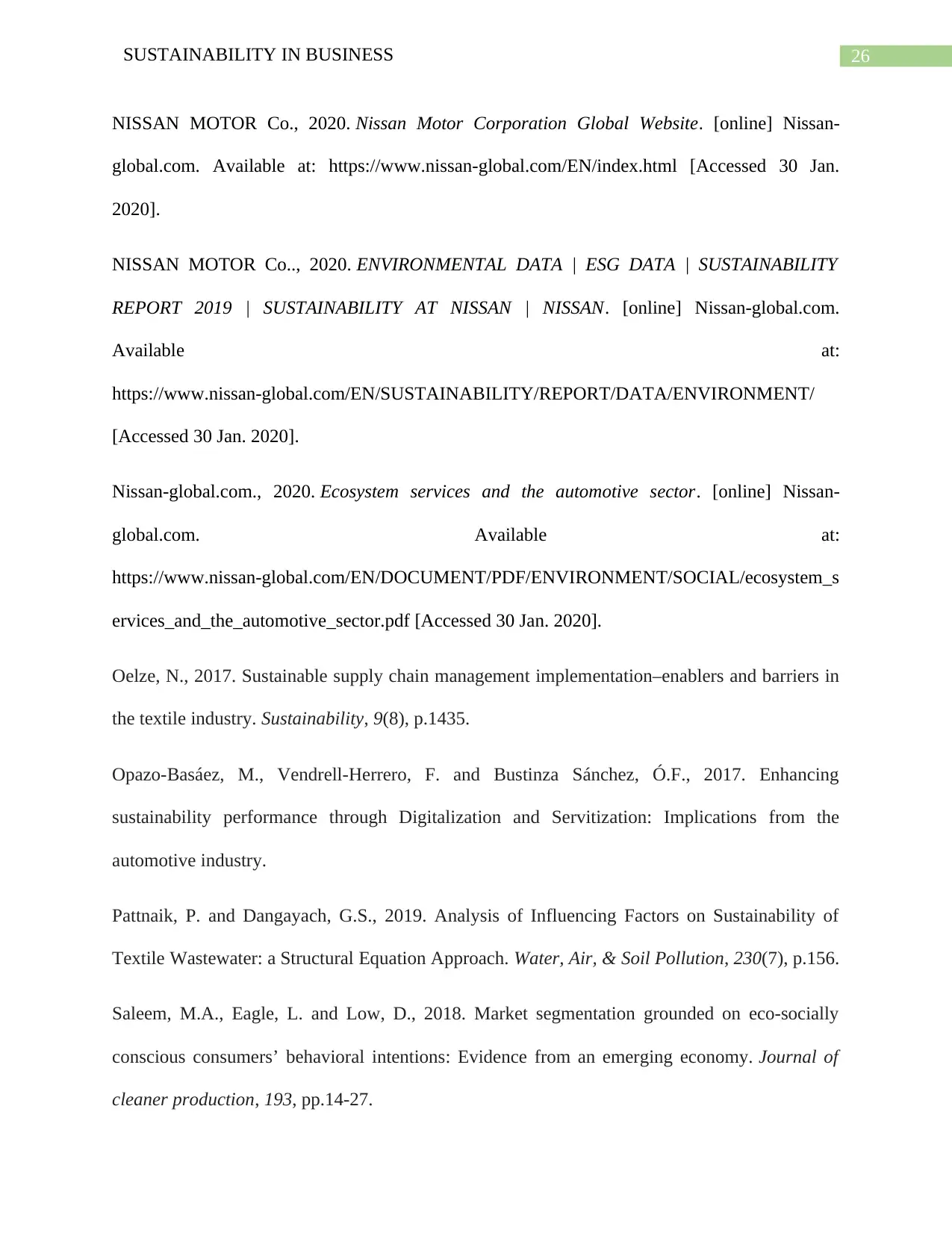
26SUSTAINABILITY IN BUSINESS
NISSAN MOTOR Co., 2020. Nissan Motor Corporation Global Website. [online] Nissan-
global.com. Available at: https://www.nissan-global.com/EN/index.html [Accessed 30 Jan.
2020].
NISSAN MOTOR Co.., 2020. ENVIRONMENTAL DATA | ESG DATA | SUSTAINABILITY
REPORT 2019 | SUSTAINABILITY AT NISSAN | NISSAN. [online] Nissan-global.com.
Available at:
https://www.nissan-global.com/EN/SUSTAINABILITY/REPORT/DATA/ENVIRONMENT/
[Accessed 30 Jan. 2020].
Nissan-global.com., 2020. Ecosystem services and the automotive sector. [online] Nissan-
global.com. Available at:
https://www.nissan-global.com/EN/DOCUMENT/PDF/ENVIRONMENT/SOCIAL/ecosystem_s
ervices_and_the_automotive_sector.pdf [Accessed 30 Jan. 2020].
Oelze, N., 2017. Sustainable supply chain management implementation–enablers and barriers in
the textile industry. Sustainability, 9(8), p.1435.
Opazo-Basáez, M., Vendrell-Herrero, F. and Bustinza Sánchez, Ó.F., 2017. Enhancing
sustainability performance through Digitalization and Servitization: Implications from the
automotive industry.
Pattnaik, P. and Dangayach, G.S., 2019. Analysis of Influencing Factors on Sustainability of
Textile Wastewater: a Structural Equation Approach. Water, Air, & Soil Pollution, 230(7), p.156.
Saleem, M.A., Eagle, L. and Low, D., 2018. Market segmentation grounded on eco-socially
conscious consumers’ behavioral intentions: Evidence from an emerging economy. Journal of
cleaner production, 193, pp.14-27.
NISSAN MOTOR Co., 2020. Nissan Motor Corporation Global Website. [online] Nissan-
global.com. Available at: https://www.nissan-global.com/EN/index.html [Accessed 30 Jan.
2020].
NISSAN MOTOR Co.., 2020. ENVIRONMENTAL DATA | ESG DATA | SUSTAINABILITY
REPORT 2019 | SUSTAINABILITY AT NISSAN | NISSAN. [online] Nissan-global.com.
Available at:
https://www.nissan-global.com/EN/SUSTAINABILITY/REPORT/DATA/ENVIRONMENT/
[Accessed 30 Jan. 2020].
Nissan-global.com., 2020. Ecosystem services and the automotive sector. [online] Nissan-
global.com. Available at:
https://www.nissan-global.com/EN/DOCUMENT/PDF/ENVIRONMENT/SOCIAL/ecosystem_s
ervices_and_the_automotive_sector.pdf [Accessed 30 Jan. 2020].
Oelze, N., 2017. Sustainable supply chain management implementation–enablers and barriers in
the textile industry. Sustainability, 9(8), p.1435.
Opazo-Basáez, M., Vendrell-Herrero, F. and Bustinza Sánchez, Ó.F., 2017. Enhancing
sustainability performance through Digitalization and Servitization: Implications from the
automotive industry.
Pattnaik, P. and Dangayach, G.S., 2019. Analysis of Influencing Factors on Sustainability of
Textile Wastewater: a Structural Equation Approach. Water, Air, & Soil Pollution, 230(7), p.156.
Saleem, M.A., Eagle, L. and Low, D., 2018. Market segmentation grounded on eco-socially
conscious consumers’ behavioral intentions: Evidence from an emerging economy. Journal of
cleaner production, 193, pp.14-27.
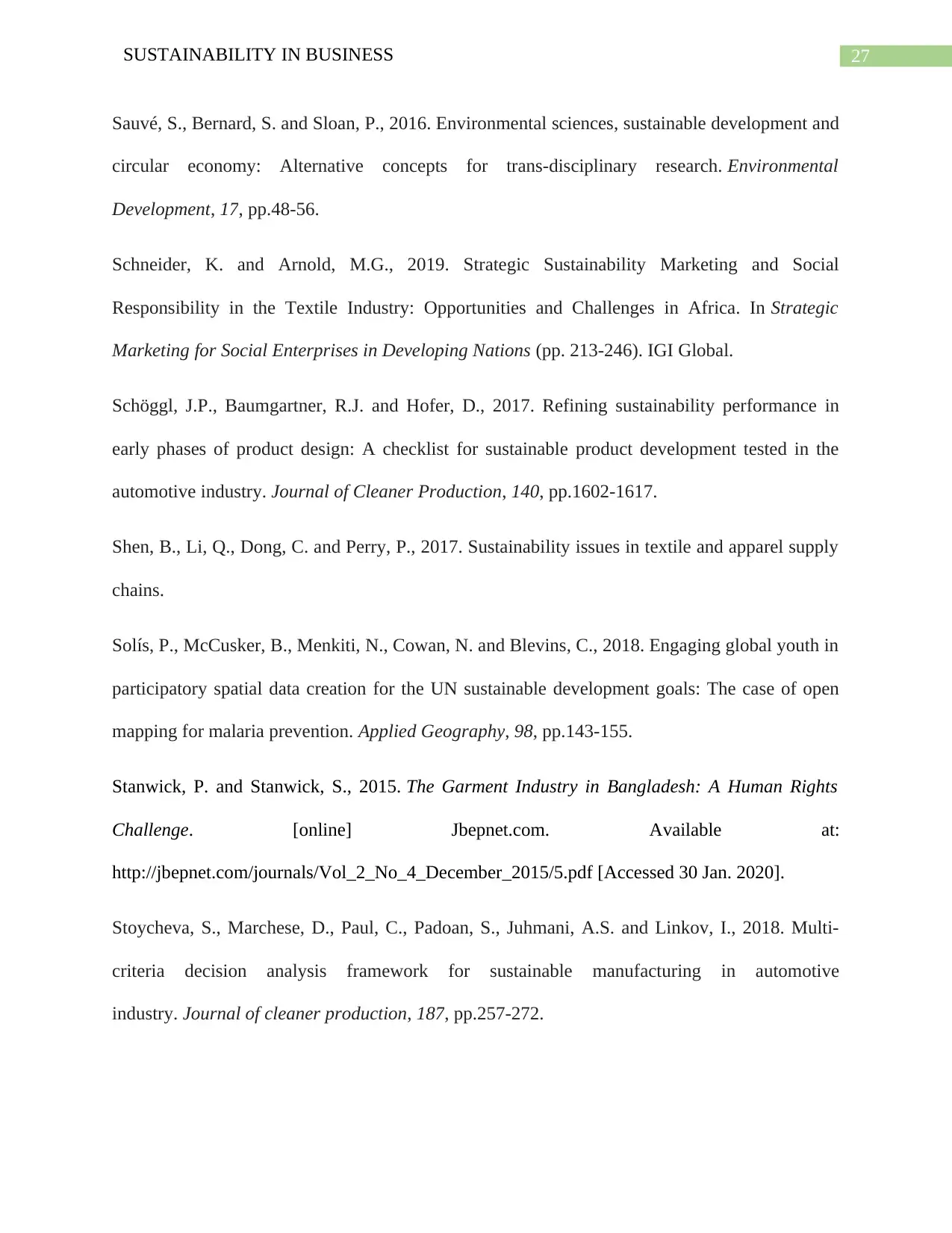
27SUSTAINABILITY IN BUSINESS
Sauvé, S., Bernard, S. and Sloan, P., 2016. Environmental sciences, sustainable development and
circular economy: Alternative concepts for trans-disciplinary research. Environmental
Development, 17, pp.48-56.
Schneider, K. and Arnold, M.G., 2019. Strategic Sustainability Marketing and Social
Responsibility in the Textile Industry: Opportunities and Challenges in Africa. In Strategic
Marketing for Social Enterprises in Developing Nations (pp. 213-246). IGI Global.
Schöggl, J.P., Baumgartner, R.J. and Hofer, D., 2017. Refining sustainability performance in
early phases of product design: A checklist for sustainable product development tested in the
automotive industry. Journal of Cleaner Production, 140, pp.1602-1617.
Shen, B., Li, Q., Dong, C. and Perry, P., 2017. Sustainability issues in textile and apparel supply
chains.
Solís, P., McCusker, B., Menkiti, N., Cowan, N. and Blevins, C., 2018. Engaging global youth in
participatory spatial data creation for the UN sustainable development goals: The case of open
mapping for malaria prevention. Applied Geography, 98, pp.143-155.
Stanwick, P. and Stanwick, S., 2015. The Garment Industry in Bangladesh: A Human Rights
Challenge. [online] Jbepnet.com. Available at:
http://jbepnet.com/journals/Vol_2_No_4_December_2015/5.pdf [Accessed 30 Jan. 2020].
Stoycheva, S., Marchese, D., Paul, C., Padoan, S., Juhmani, A.S. and Linkov, I., 2018. Multi-
criteria decision analysis framework for sustainable manufacturing in automotive
industry. Journal of cleaner production, 187, pp.257-272.
Sauvé, S., Bernard, S. and Sloan, P., 2016. Environmental sciences, sustainable development and
circular economy: Alternative concepts for trans-disciplinary research. Environmental
Development, 17, pp.48-56.
Schneider, K. and Arnold, M.G., 2019. Strategic Sustainability Marketing and Social
Responsibility in the Textile Industry: Opportunities and Challenges in Africa. In Strategic
Marketing for Social Enterprises in Developing Nations (pp. 213-246). IGI Global.
Schöggl, J.P., Baumgartner, R.J. and Hofer, D., 2017. Refining sustainability performance in
early phases of product design: A checklist for sustainable product development tested in the
automotive industry. Journal of Cleaner Production, 140, pp.1602-1617.
Shen, B., Li, Q., Dong, C. and Perry, P., 2017. Sustainability issues in textile and apparel supply
chains.
Solís, P., McCusker, B., Menkiti, N., Cowan, N. and Blevins, C., 2018. Engaging global youth in
participatory spatial data creation for the UN sustainable development goals: The case of open
mapping for malaria prevention. Applied Geography, 98, pp.143-155.
Stanwick, P. and Stanwick, S., 2015. The Garment Industry in Bangladesh: A Human Rights
Challenge. [online] Jbepnet.com. Available at:
http://jbepnet.com/journals/Vol_2_No_4_December_2015/5.pdf [Accessed 30 Jan. 2020].
Stoycheva, S., Marchese, D., Paul, C., Padoan, S., Juhmani, A.S. and Linkov, I., 2018. Multi-
criteria decision analysis framework for sustainable manufacturing in automotive
industry. Journal of cleaner production, 187, pp.257-272.
Secure Best Marks with AI Grader
Need help grading? Try our AI Grader for instant feedback on your assignments.
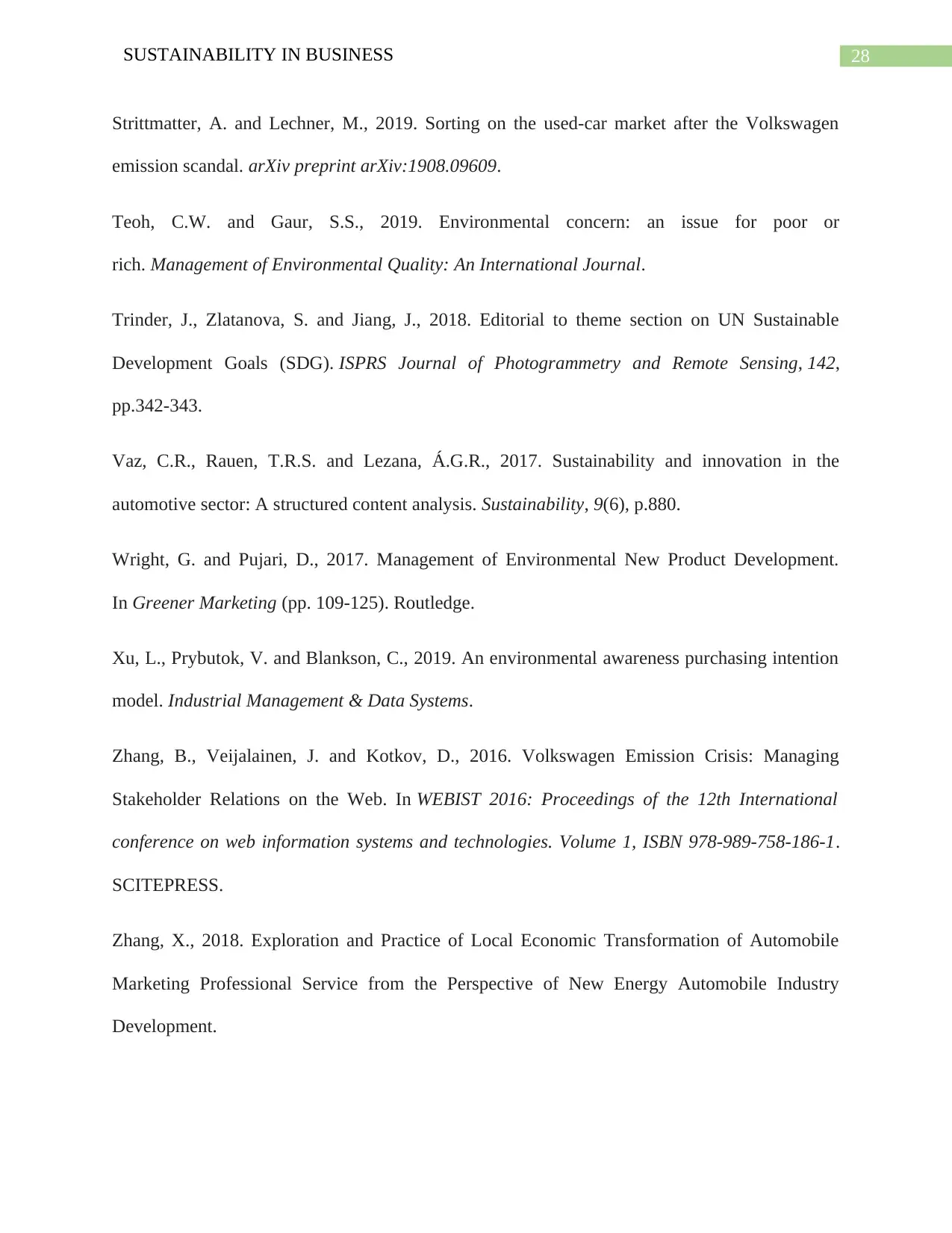
28SUSTAINABILITY IN BUSINESS
Strittmatter, A. and Lechner, M., 2019. Sorting on the used-car market after the Volkswagen
emission scandal. arXiv preprint arXiv:1908.09609.
Teoh, C.W. and Gaur, S.S., 2019. Environmental concern: an issue for poor or
rich. Management of Environmental Quality: An International Journal.
Trinder, J., Zlatanova, S. and Jiang, J., 2018. Editorial to theme section on UN Sustainable
Development Goals (SDG). ISPRS Journal of Photogrammetry and Remote Sensing, 142,
pp.342-343.
Vaz, C.R., Rauen, T.R.S. and Lezana, Á.G.R., 2017. Sustainability and innovation in the
automotive sector: A structured content analysis. Sustainability, 9(6), p.880.
Wright, G. and Pujari, D., 2017. Management of Environmental New Product Development.
In Greener Marketing (pp. 109-125). Routledge.
Xu, L., Prybutok, V. and Blankson, C., 2019. An environmental awareness purchasing intention
model. Industrial Management & Data Systems.
Zhang, B., Veijalainen, J. and Kotkov, D., 2016. Volkswagen Emission Crisis: Managing
Stakeholder Relations on the Web. In WEBIST 2016: Proceedings of the 12th International
conference on web information systems and technologies. Volume 1, ISBN 978-989-758-186-1.
SCITEPRESS.
Zhang, X., 2018. Exploration and Practice of Local Economic Transformation of Automobile
Marketing Professional Service from the Perspective of New Energy Automobile Industry
Development.
Strittmatter, A. and Lechner, M., 2019. Sorting on the used-car market after the Volkswagen
emission scandal. arXiv preprint arXiv:1908.09609.
Teoh, C.W. and Gaur, S.S., 2019. Environmental concern: an issue for poor or
rich. Management of Environmental Quality: An International Journal.
Trinder, J., Zlatanova, S. and Jiang, J., 2018. Editorial to theme section on UN Sustainable
Development Goals (SDG). ISPRS Journal of Photogrammetry and Remote Sensing, 142,
pp.342-343.
Vaz, C.R., Rauen, T.R.S. and Lezana, Á.G.R., 2017. Sustainability and innovation in the
automotive sector: A structured content analysis. Sustainability, 9(6), p.880.
Wright, G. and Pujari, D., 2017. Management of Environmental New Product Development.
In Greener Marketing (pp. 109-125). Routledge.
Xu, L., Prybutok, V. and Blankson, C., 2019. An environmental awareness purchasing intention
model. Industrial Management & Data Systems.
Zhang, B., Veijalainen, J. and Kotkov, D., 2016. Volkswagen Emission Crisis: Managing
Stakeholder Relations on the Web. In WEBIST 2016: Proceedings of the 12th International
conference on web information systems and technologies. Volume 1, ISBN 978-989-758-186-1.
SCITEPRESS.
Zhang, X., 2018. Exploration and Practice of Local Economic Transformation of Automobile
Marketing Professional Service from the Perspective of New Energy Automobile Industry
Development.
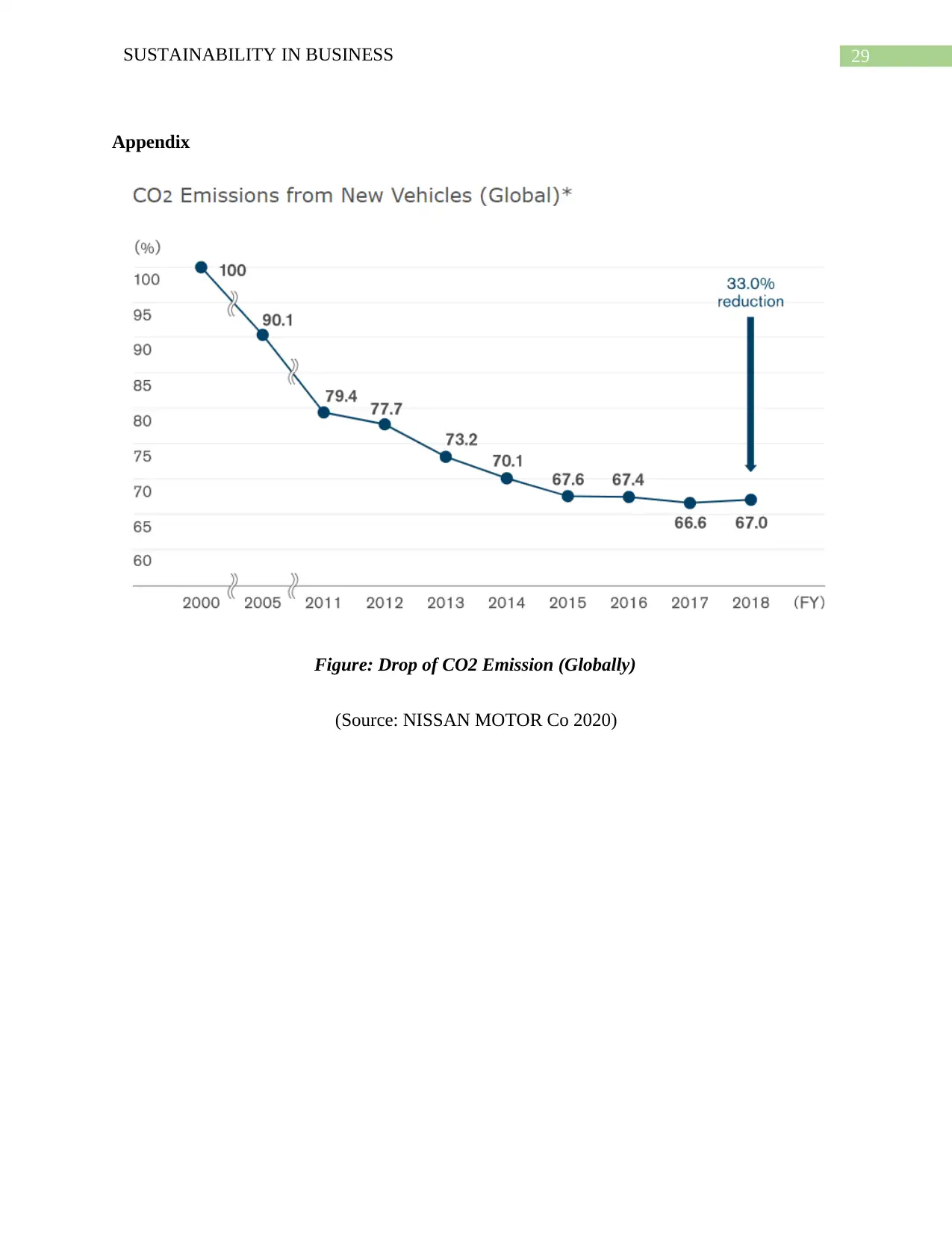
29SUSTAINABILITY IN BUSINESS
Appendix
Figure: Drop of CO2 Emission (Globally)
(Source: NISSAN MOTOR Co 2020)
Appendix
Figure: Drop of CO2 Emission (Globally)
(Source: NISSAN MOTOR Co 2020)
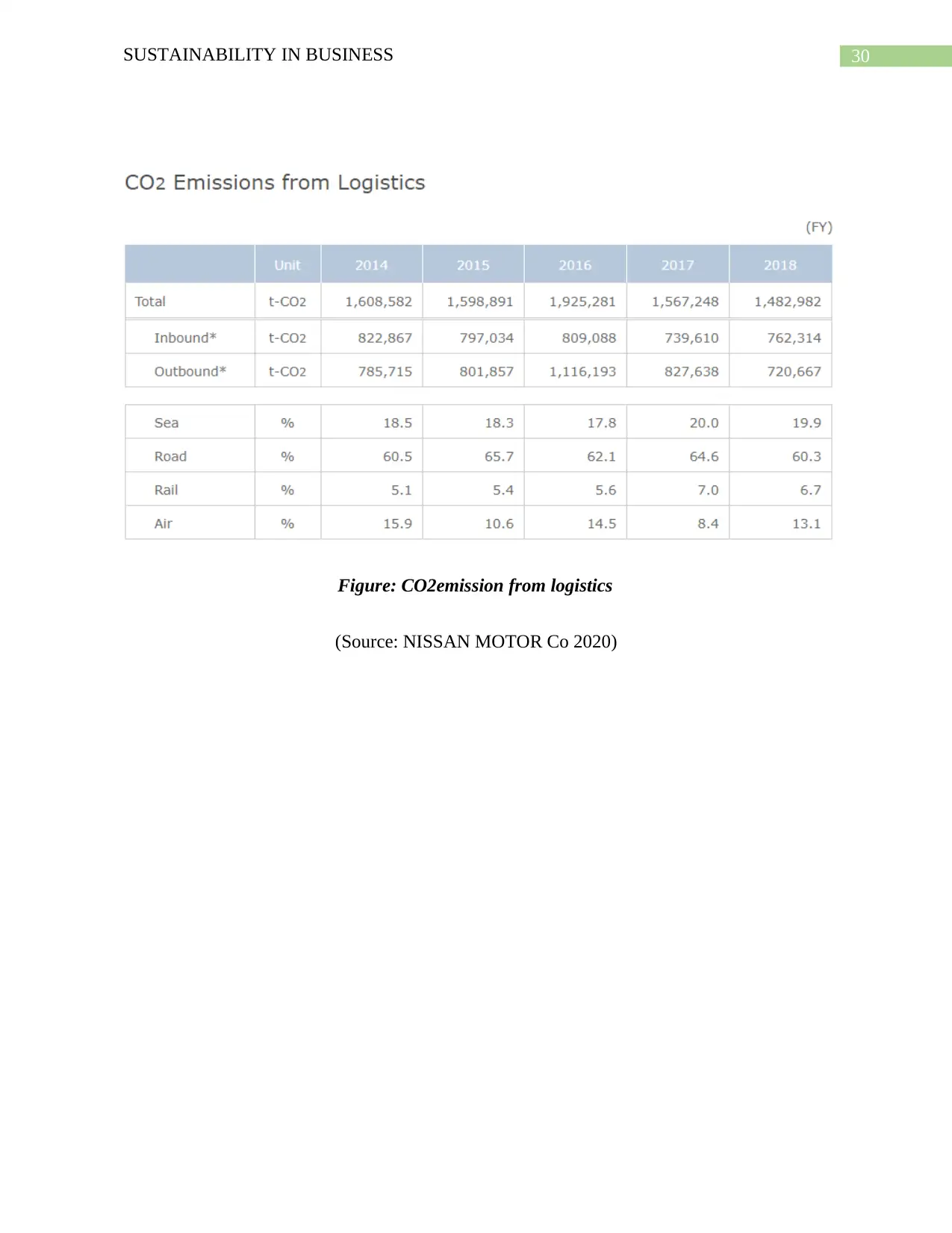
30SUSTAINABILITY IN BUSINESS
Figure: CO2emission from logistics
(Source: NISSAN MOTOR Co 2020)
Figure: CO2emission from logistics
(Source: NISSAN MOTOR Co 2020)
1 out of 31
Related Documents
Your All-in-One AI-Powered Toolkit for Academic Success.
+13062052269
info@desklib.com
Available 24*7 on WhatsApp / Email
![[object Object]](/_next/static/media/star-bottom.7253800d.svg)
Unlock your academic potential
© 2024 | Zucol Services PVT LTD | All rights reserved.





